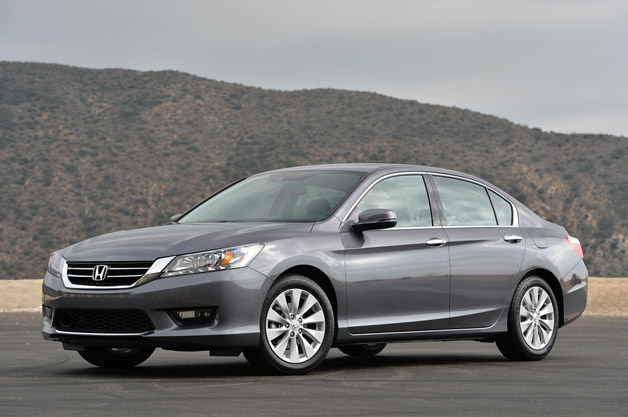View Poll Results: What do you like Better?
Accord Concept Rims and Bodykit




54
73.97%
2004 Acura TL A-Spec Bodykit and Rims




19
26.03%
Voters: 73. You may not vote on this poll
Honda: Accord News
#3721
Senior Moderator
Join Date: May 2003
Location: Better Neighborhood, Arizona
Posts: 45,641
Received 2,329 Likes
on
1,309 Posts
out of the 2 s2000 i had, i don't think i had ever seen anything over 25mpg even when i tried, even during my 300 miles trips to Vegas. 240 - 280 miles per tank, which is what most of the people get on s2ki too.
You need to start driving s2000 like it meant to be driven.....
You need to start driving s2000 like it meant to be driven.....


#3722
Safety Car
Most of the attention for Honda's Accord hybrid will come from its eye-popping 50-mpg EPA city rating and under-$30,000 starting price. But those with an eye for engineering will see a creative combination of new technology with elements from the Chevrolet Volt, Toyota Prius and Ford Fusion Hybrid.
"Honda put in all we had," said Koji Ninomiya, chief engineer for the Accord Hybrid, through an interpreter. "We did our best, and we ended up at 50 mpg."
The car, which gets to dealerships in late October, uses 3 drive modes to crack the 50-mpg figure -- something no other mid-sized car, including the European diesels, can match.
Ninomiya said 50 mpg or any specific number was not the goal when Honda engineers began nearly a decade ago studying a new hybrid powertrain to replace its current design.
"We considered everything, [including] driving resistance and regenerative braking. We made the powertrain all new, and the biggest purpose of this was to aim for the most efficient system in the world. As we tried to optimize the efficiency, we decided 2 motors will be best," he said.
Here's how the 2 electric motors work in the Accord Hybrid's 3 drive modes, EV, Hybrid and Engine.
• EV mode: The car is propelled only by an electric motor powered by the lithium ion battery pack. The top speed is about 60 mph, but the range is very limited, just a few miles. Once the battery is depleted, the car automatically switches to Hybrid mode.
• Hybrid mode: The Accord Hybrid works a lot like a Chevrolet Volt. The 2.0-liter gasoline engine powers a generator to create electricity for the electric motor. Honda calls the generator a motor, hence 2 motors. Only the electric motor, fed by the generator, moves the car in Hybrid mode.
• Engine mode: The electric motor is decoupled, and the Accord's Atkinson cycle gasoline engine drives the wheels directly through a 1-gear transmission. In that highway gear -- similar in efficiency to a 6th gear on a manual transmission -- the gasoline engine runs in its sweet spot, delivering both strong acceleration when needed and high fuel economy.
Ford and Toyota hybrids also use Atkinson cycle engines. The Accord's Atkinson cycle 2.0-liter gasoline engine is a 1st for Honda.• Hybrid mode: The Accord Hybrid works a lot like a Chevrolet Volt. The 2.0-liter gasoline engine powers a generator to create electricity for the electric motor. Honda calls the generator a motor, hence 2 motors. Only the electric motor, fed by the generator, moves the car in Hybrid mode.
• Engine mode: The electric motor is decoupled, and the Accord's Atkinson cycle gasoline engine drives the wheels directly through a 1-gear transmission. In that highway gear -- similar in efficiency to a 6th gear on a manual transmission -- the gasoline engine runs in its sweet spot, delivering both strong acceleration when needed and high fuel economy.
http://bcove.me/wo557r58
In an Atkinson cycle engine, the intake valves remain open briefly during the compression stroke. That pushes some of the air in the cylinders into the intake manifold, which lowers the compression ratio. That enables fast, smooth starts, which is ideal for hybrids. The downside is that it reduces power.
To solve that problem, Honda engineers installed VTEC, a system that electronically controls the timing of the valves with camshafts that have 2 sets of lobes. 1 set of lobes is for the Atkinson cycle; the other is for normal combustion. The engine's computer switches back and forth between the 2 sets of lobes, based on engine speed and load.
Other new technologies include the car's innovative regenerative brakes, which send electricity to the battery. Regeneration begins the instant a driver's foot leaves the accelerator, not when the brake pedal is pressed as it does on other hybrids.
The air-cooled lithium ion battery pack fits in a compact case between the rear seat and the trunk. The pack does reduce trunk space. The hybrid's trunk is 12.7 cubic feet, while the regular Accord's trunk is 15.8.
Honda will offer 3 versions of the Accord Hybrid. The base model starts at $29,155; a midlevel E-XL version, at $31,905; and the loaded Touring, at $34,905. The prices exclude shipping; figures haven't been announced.
Watch the technology in action
http://bcove.me/bt05m62r
http://bcove.me/bt05m62r
Honda is assembling the Accord Hybrid at its Marysville plant; it is the 1st time the Accord Hybrid has been built in North America.
The car's innovative powertrain could help win back some former Honda fans who deserted the brand for other makes with more advanced engines and transmissions.
In the past, Honda had stuck with nickel-metal hydride batteries in its hybrids while other automakers developed more efficient gasoline-electric powertrains that use lighter, stronger lithium ion batteries.
And in its gasoline-powered cars, the company has been slow to shift to automatic transmissions with more than four speeds.
The result of that strategy: middle-of-the-pack fuel economy ratings and a string of misfires dating back nearly a decade, including the failed 2004-06 Accord Hybrid, a slow selling Civic Hybrid and dismal sales for the Insight and CR-Z hybrids.
The Accord Hybrid's 50 mpg is "a pretty strong statement," said California dealer Dave Conant. He is CEO of The C.A.R. Group, which owns 13 stores, including four Honda outlets.
"For a long time Honda sort of owned the territory," he said. "I think a 50-mpg Accord is going to absolutely swing people back to thinking of Honda as a fuel economy leader. It's long overdue, honestly."
The following users liked this post:
Legend2TL (10-21-2013)
#3723
Azine Jabroni
This is absolutely brilliant considering how close a good portion of Americans live to work. At the same time, it's not completely useless like a Leaf, and so much cheaper than a Volt.
#3724
You'll Never Walk Alone
iTrader: (1)
Join Date: Jun 2005
Location: Vancouver, BC, Canada
Age: 37
Posts: 9,493
Received 835 Likes
on
519 Posts
Back on topic - I do find the mpg numbers impressive on the Accord Hybrid. I'm curious to read the reviews on the car and see some performance numbers - I know performance isn't what I should be looking for out of a Hybrid - but I'd like to see how much I lose going from the Accord Touring V6 to the Accord Touring Hybrid. Still trying to decide what I want to replace my '03 TL-S with, feel like I've been waiting forever for the TLX. I do really like the new Accord though - and 50mpg sounds very attractive.
Car and Driver did a test on the Accord PLUG-IN hybrid:
http://www.caranddriver.com/reviews/...in-test-review
Zero to 60 mph: 7.7 sec
Zero to 100 mph: 22.1 sec
Zero to 110 mph: 29.6 sec
Rolling start, 5–60 mph: 7.9 sec
Top gear, 30–50 mph: 3.8 sec
Top gear, 50–70 mph: 5.8 sec
Standing ¼-mile: 16.1 sec @ 88 mph
Curb weight: 3783 lb
The plug-in version has a much larger and heavier battery pack (I believe it's 5 times the capacity of the regular hybrid?). As such, I think the regular hybrid should be at least 200lb lighter than the plug-in model. I would guesstimate 0-60mph is about 7.5s and 1/4 mile in 15.8s@90mph. I think it will be a decently quick car but nowhere near your TL-S, let alone the Accord V6 Touring. That car is about 2 seconds faster to 60mph and 1/4 mile while trapping at over 100mph.
The following users liked this post:
LiQiCE (10-04-2013)
#3725
Liquid Ice
Haha, same here...I have been waiting forever for the TLX...trying to see what I want to replace my 2g TL-S with. And just like you, at this moment, I like the Accord a lot, especially the v6 touring trim. But the hybrid is also interesting.
The plug-in version has a much larger and heavier battery pack (I believe it's 5 times the capacity of the regular hybrid?). As such, I think the regular hybrid should be at least 200lb lighter than the plug-in model. I would guesstimate 0-60mph is about 7.5s and 1/4 mile in 15.8s@90mph. I think it will be a decently quick car but nowhere near your TL-S, let alone the Accord V6 Touring. That car is about 2 seconds faster to 60mph and 1/4 mile while trapping at over 100mph.
The plug-in version has a much larger and heavier battery pack (I believe it's 5 times the capacity of the regular hybrid?). As such, I think the regular hybrid should be at least 200lb lighter than the plug-in model. I would guesstimate 0-60mph is about 7.5s and 1/4 mile in 15.8s@90mph. I think it will be a decently quick car but nowhere near your TL-S, let alone the Accord V6 Touring. That car is about 2 seconds faster to 60mph and 1/4 mile while trapping at over 100mph.
#3726
I have to say over the years the honda accord has came a long way, cant compare the recent accords to the first and second gen accords. Accords really grew on me over the years. Good shitt
#3727
Safety Car
Will history repeat itself, or will a whole new chapter in Honda hybrids be written? With the introduction of the 2014 Honda Accord Hybrid, the brand is hoping to erase any trace of Accord Hybrids past with a new vehicle flush with technology and handsomely wrapped in its own style.
On its last go-around about a decade ago, the Accord Hybrid launched as a slightly sportier alternative. It was, to put it bluntly, a flop. But this time, the Accord Hybrid comes pre-loaded with lots of technology.
Honda chose Texas Hill Country to launch the new vehicle. It turns out, it was just about the perfect place to put the newer tech to the test with its perfect mix of rolling hills, sweeping turns, longhorns, barbeque in the shadow of Austin's Silicon Hills. C’mon, y’all.
Prime power
The Accord Sedan lineup grows to 3 strong, bookended by the top-of-the-line Accord PHEV plug-in hybrid and the standard internal combustion engine-powered Accord. In the middle: The new Accord Hybrid.
For the Accord Hybrid, the singular power plant offering is a 2.0-liter 4-cylinder DOHC iVTEC Atkinson-cycle engine (a Honda 1st) that makes 141-horsepower and 122 lb-ft of torque. The 4-banger is enhanced by 2 electric-powered generator motors, which make 166 horsepower and 226 lb-ft of torque. When combined, it yields a total of 196 horsepower overall. The system is mated to an Electric Continuously Variable transmission (E-CVT), and the EPA says it is possible to achieve 50 city/45 highway with a combined rating of 47 mpg. Based on those figures, Honda claims a range of 673 gas-electric miles from a full tank of fuel.
Honda's goal was to aim for the most efficient powertrain system that could be designed. Nothing was off the table as far as technologies went, and the goal was to surpass the less than successful efforts of the last Hybrid Accord, as well as those of its competition like the Ford Fusion Hybrid and Toyota Camry Hybrid.
For the new Accord Hybrid, motivation comes from 2 motors in addition to the gasoline VTEC engine. From a standing start, after ignition, energy from the battery is sent to the drive motor and the car starts to move in EV mode. This pure electric mode can propel the car up to 60 mph for a distance of around 2 miles. As is normally the case, the need for more current will cause the gas engine to fire. The generator motor then starts to make electricity for the drive motor, which then causes the car to move. The result is instant torque as in a slot car.
An additional engine mode now exists, which causes operations similar to a Chevrolet Volt. Using a one-gear transmission, with a gear ratio like a 6th gear direct-style drive, the engine operates as needed for fast acceleration.
On the other end of the spectrum, the Accord Hybrid features regenerative braking to recoup some energy loss from the batteries. Unlike other systems that operate when the brakes are applied, the Accord starts regeneration when drivers take their feet from the accelerator. Power is sent back to the lithium ion batteries, housed in the Intelligent Power Unit, which reduces the Hybrid Accord’s trunk space to 12.7 cubic feet from the standard Accord’s 15.8 cubic foot trunk.
Ride quality is everything we have grown to like about the Accord. The Hybrid uses a similar MacPherson strut front kit and independent multilink rear suspension to keep contact with the road, while new amplitude reactive dampers and an electric servo brake system join into the mix. The dampers are adjusted to react to low and high speed movements, while the servo brakes assist with the regenerative braking functions.
Accord has the Blues
Like many Hybrid models in the industry, the Honda Accord Hybrid uses blue accents to differentiate itself from the average run-of-the-mill offerings that make up the rest of its stables. The result is blue-tinted chrome wings in the grill, as well as blued chrome headlight surrounds that immediately let a casual observer know that you’ve got your hybrid freak flag on.
Other than the blue accents, hybrid badging and unique 17-inch aero-styled wheels, it would appear as though your next door neighbor might have driven off his dealer lot driving a common everyday version of one of the most popular vehicles in North America. The only other giveaway would be the aero-tuned rear deck spoiler.
A trio of trims will be on offer: Base, EX-L and loaded up Limited.
If your liked the interior of the newly designed ninth-generation 2013 Honda Accord Sedan, you will be equally at home in the Accord Hybrid. Everything from the well-designed front seating with nicely contoured bolstering to the more than accommodating (and relatively deep-set) rear seats with their substantial legroom and width for three passengers, has been carried over into this new model. The only substantial change occurs in the instrument binnacle with the addition of new meters to help drivers achieve the most efficient driving style.
While Ford and others may embrace leaves that grow or wither, depending on your pressure on the skinny peddle, Honda chose to keep it simple with a Power/Charge meter on the left side of the speedometer that lets you know how efficient you truly may be.
We tested both the base and top-of-the-line Touring versions of the Accord Hybrid and found them both well-equipped with soft touch material throughout. The standard version featured a high-quality fabric seat covering, but we would opt for the full-cow leather seating found in the Touring.
Hill Country rambling
From our starting point located in a Texas valley between several hills, the electric motor was the first to engage, sending the car off from a standing start. At 1st we heard the whirring of the generator motor, and then the thrum of the iVTEC 4-cylinder Atkinson-cycle engine, which tended to cause a bit of squawking from underhood, letting us know that a combination of motivating factors were at play at the same time. Once we found relatively level road surfaces, it was clear if we listened closely that the gas engine was taking a breather, while the electric power unit was doing most of the heavy lifting.
While cruising on the highway, the direct-drive 6th gear engaged - but not always. For instance, we heard the electric motor whine up while we attempted a pass on 1 of the major highways around San Antonio. After we stabilized our speed, the wet clutch once again engages the direct drive in a fashion that was almost imperceptible. It was up to the Intelligent Power Unit to determine which was the best use of energy for the task at hand.
This continued through most of our drive along dual-lane highways in the area. Keeping an eye on the mpg-e (mpg equivalent) meter, we started off slow and steady through the backroads of a state that could fit the 23 smallest European countries within its borders.
Honda and the EPA cite a 50 mpg city rating from the Accord. We think they are sandbagging. While we never claim to be hypermilers, it was not too difficult to surpass that figure. Before we knew it, our gauge was reading out a measure of 58.3 mpg average for an admittedly hand-chosen combined city/highway route. Some of our tree-hugging colleagues, through the use of annoying slow speed driving tactics, no air conditioning and windows-up conditions in 95 degrees of Texas heat, easily surpassed that for an 83.7 mpg average.
We’ll let them take the prize this time, but, suffice to say, Honda might have the most appealing fuel miser yet on its hands.
Leftlane's bottom line
Prodigal son Honda returns with its latest Accord Hybrid offering and we’d have to say all things are forgiven. Using innovative technology in a well-received and recognized package, at a reasonable price, will only heat up the Hybrid Wars.
This time, they’ll be ready.
#3728
Safety Car
Honda says it has found a way to improve the efficiency of hybrids—and in all likelihood significantly lower the cost to build them. For its new Honda Accord Hybrid, which goes on sale across the U.S. at the end of the month, it’s done away with the car’s transmission.
Hybrids could help automakers meet fuel economy regulations, but their sales are limited by high costs, which are as much as $5,000 more than conventional cars. It may eventually be possible to reduce the price gap to 0, according to a spokesperson from Honda.
Hybrids typically use complex transmissions, or power splitters, to coordinate between the gasoline engine and electric motor that propel hybrids. To get rid of this system, engineers designed the new Accord Hybrid so that most of the time the gas engine isn’t mechanically connected to the wheels. It serves only to spin a generator, which charges a battery. The battery then delivers electricity to a motor that drives the wheels. Electric motors can operate over a wide variety of speeds, eliminating the need to shift gears. To this point, the new design isn’t novel–it’s known as a series hybrid design.
But series hybrids aren’t always as efficient as hybrids that use a transmission. You lose energy when you convert the mechanical energy from the engine into electric energy to charge the battery, and then back into mechanical energy via a motor. (Taking this hit makes sense sometimes, since storing energy in a battery makes it possible to keep the engine operating in its sweet spot, avoiding loads and speeds where it’s very inefficient.) In the early days of talking about the Chevrolet Volt, GM made it sound like it would be a series hybrid. But engineers introduced a complex transmission to allow the gas engine to drive the wheels directly in some situations, improving efficiency by 10 to 15%.
Honda found a simpler approach. It uses the electric motor to get the car up to a steady, highway speed. At that point, a clutch allows the gas engine to drive the wheels directly. Basically, the car has only 1 high gear, and it uses the electric motor in lieu of all the other gears.
Honda says this system is key to allowing the car to get 50 miles per gallon in the city and 45 miles per gallon on the highway, impressive figures for a car its size. In comparison, the non-hybrid version of the Accord gets 26 mpg city and 34 mpg highway, and the similarly sized Toyota Camry Hybrid only gets 43 mpg in the city and 39 on the highway. (The Ford Fusion Hybrid officially comes close, with 47 mpg in both the city and highway, but Consumer Reports found the actual mileage was far lower—just 35 and 41 in city and highway.)
The new approach does have the potential to reduce costs and improve efficiency, says John Heywood, a professor of mechanical engineering at MIT. But he notes that transmissions are also getting very efficient, so every automaker isn’t necessarily going to take this path. He expects the cost difference between hybrids and conventional vehicles to decline to $2,000 by 2030. “Costs will come down, but there’s a lot more stuff in a hybrid, so it’s inevitably going to cost somewhat more,” he says.
#3729
Safety Car
The 2014 Honda Accord Hybrid made a high-pitched whirring sound as I scooted down a suburban street in Columbus, Ohio.
It was in EV mode and my goal was to max out the Accord's fuel economy. It's a typical challenge from a carmaker that is touting a new high-mileage vehicle.
The Accord Hybrid, a 2nd hybrid try for Honda, is the kind of eco-friendly vehicle everyone expected in the 1st place. It's just taken Honda a few years to deliver a fuel sipper with that futuristic electric-car feel. It can cruise at slower speeds in electric only mode and then -- when it hits the highway or when the lithium ion battery pack runs low -- a gas engine kicks on to help drive the car.
Touting its new Earth Dreams drive train, the Accord Hybrid uses 2 electric motors and a gas engine to hit 50 mpg in city driving and 45 mpg on highway driving, according to Environmental Protection Agency testing. Around Columbus, I was averaging 70 mpg, according to the on-board fuel read out.
Yes, I readily admit some light-footed driving, nursing the electric motors to pull the car gently instead of mashing the accelerator to kick on the 2-liter 4-cylinder engine, which would then eat up my high-mileage numbers.
Ultimately, I finished the short course averaging 68 mpg, placing 3rd with 3 other journalists topping me with 77 and 74 mpg. Not bad at all, though a few drivers behind me may have thought differently.
Really, overall, the new Accord is not bad at all either. Built on the 2013 Accord platform, the new hybrid delivers solid performance whether hypermiling or just cruising in a more traditional fashion. The sedan is extremely quiet, nicely laid out and arrives with middle-of-the-road looks. It's certainly not as aggressively styled as the Ford Fusion or Hyundai Sonata, which also have hybrid versions, but it's sharper than top-selling Toyota Camry. However, fashion has never been the most important factor in the cutthroat midsize sedan segment.
Honda, which had fallen behind other carmakers with its hybrid models, seems to have put the right ingredients together this time, creating a high-tech sedan that comes loaded with creature comforts, safety features and an impressive drivetrain.
Honda plans on launching both a regular gas-electric hybrid and a plug-in hybrid with the Accord. I was only able to drive the regular hybrid.
While they will use different-sized battery packs -- the plug-in model uses a 6.7 kilowatt hour pack and the regular hybrid uses a 1.3 kWh pack -- both will share the same drivetrain, which consists of a 2-liter 4-cylinder engine, running on the more efficient Atkinson cycle, and 2 electric motors, which Honda calls its Intelligent Multi-Mode Drive (i-MMD) System. All told, the systems produce 196 horsepower.
The drivetrain allows the plug-in and regular hybrid to run as either a series hybrid or parallel hybrid, meaning the gas engine will either power a generator to continue electric only operation or it will help turn the wheels of the car. This is a much different set up than most hybrids, which use the gas engine only to drive the car when needed and then rely on regenerative braking to recharge the batteries.
It's only noticeable that you're in EV mode via a light on the dash. Otherwise, it's almost impossible to tell when the gas engine is running and when it is not because the Accord is so quiet.
Like many other hybrids, Honda includes electric power steering, low rolling resistant tires, and adds to that an electric air-conditioning compressor and water pump to minimize parasitic losses to the engine.
Honda has created a more efficient regenerative braking system it calls Electro Servo Braking, which uses a hydraulic braking system that is activated by an electronic actuator. The result is much more responsive brakes that don't have that mushy feel some hybrids offer. The regenerative braking part begins the moment the driver removes his foot from the accelerator -- though it's not so aggressive as to cause the car to slow noticeably. (There is a braking mode on the gear shifter, which allows for more aggressive regeneration.)
The electronic continuously variable transmission also works better than most CVTs. It avoids heavy whines and provides nice pauses during heavy acceleration to give it a feel of a regular gear-based slush box.
Overall, this hybrid feels more like a regular car if you want something that just rides quietly, gets good fuel economy and has enough power to cruise at 80 mph on the highway -- something no 1 should do for very long in Ohio.
The steering is a little numb and the return to center did not have much snap, but my expectation for most midsize sedans is not one of sports-car feel. It's a family hauler and the Accord, which has entered its 9th generation, will continue to do just that very well.
Honda has also made some improvements to the 2013 chassis by replacing some steel parts of the front sub frame with aluminum pieces, as well as adding an aluminum hood to make the Accord hybrid lighter. The body, however, remains extremely stiff and did not sway much during harder cornering.
On the highway, the Accord was quiet with a modest amount of road noise making its way into the cabin. However, Honda has added an active noise cancelation system to the cabin to help rid it of some noise.
Inside the cabin, the Accord Hybrid's interior is simple and elegant. The center stack is similar to the regular sedan. There's an 8-inch color screen at the top of the stack with 2 tiers of buttons and knobs. I find Honda's telematics system clunky to use via a control knob but everything does work once you get used to it. The dash and seats feel of high quality materials and everything is put together well.
Honda also uses that screen to display its LaneWatch feature that mounts a camera to the passenger side external mirror. The image will show the car's blind spot, meaning the driver does not need to turn his head 90 degrees to see the blind spot. While a neat piece of technology, I find it mostly pointless. Perhaps the 1 place it would come in handy is Portland, Ore., where having a peek behind you for bicyclists approaching before making a right-hand turn would come in handy. Other than that, I cannot find a use for it other than to impress passengers.
There are more useful features, though, with the Accord Hybrid, which also come on the regular Accords. Features such as Forward Collision Warning, Adaptive Cruise Control and Lane Departure Warning, are quickly becoming required features in this segment. All can make drivers safer.
Add to that all of the standard features on the Accord Hybrid ranging from Bluetooth connectivity and dual climate controls to rearview camera, 160-Watt six-speaker stereo, and the $30,000 price tag seems pretty reasonable.
Mostly, though, the Accord Hybrid feels surprisingly normal. Honda has had a tough go with hybrids, even though it brought the 1st gas-electric hybrid to America 14 years ago.
During that time, Toyota has gone on to claim hybrid superiority while Honda developed a system that consumers overwhelmingly rejected. Now, with its new system, consumers should find themselves getting exactly what they expected in a hybrid: slow speed electric operation, fewer visits to the pump and a nameplate with a nearly bulletproof reputation.
No, that's not bad at all. In fact, it's pretty good.
2014 Honda Accord Hybrid
BASE PRICE $29,945
VEHICLE LAYOUT Front-engine, FWD, 5-pass, 4-door sedan
ENGINE 2.0L/141-hp/122-lb-ft Atkinson-cycle DOHC 16-valve I-4 plus 166-hp/226-lb-ft AC permanent-magnet electric motor; 196 hp comb
TRANSMISSION Cont. variable auto
CURB WEIGHT 3550-3600 lb (mfr)
WHEELBASE 109.3 in
LENGTH X WIDTH X HEIGHT 192.2 x 72.8 x 57.5 in
0-60 MPH N/A
EPA CITY/HWY FUEL ECON 50/45 mpg
ENERGY CONSUMPTION, CITY/HWY 67/75 kW-hrs/100 miles
CO2 EMISSIONS 0.41 lb/mile
ON SALE IN U.S. October 2013
BASE PRICE $29,945
VEHICLE LAYOUT Front-engine, FWD, 5-pass, 4-door sedan
ENGINE 2.0L/141-hp/122-lb-ft Atkinson-cycle DOHC 16-valve I-4 plus 166-hp/226-lb-ft AC permanent-magnet electric motor; 196 hp comb
TRANSMISSION Cont. variable auto
CURB WEIGHT 3550-3600 lb (mfr)
WHEELBASE 109.3 in
LENGTH X WIDTH X HEIGHT 192.2 x 72.8 x 57.5 in
0-60 MPH N/A
EPA CITY/HWY FUEL ECON 50/45 mpg
ENERGY CONSUMPTION, CITY/HWY 67/75 kW-hrs/100 miles
CO2 EMISSIONS 0.41 lb/mile
ON SALE IN U.S. October 2013
#3730
Safety Car
Honda's venerable Accord sedan is on the verge of reaching new fuel-economy heights. It's not as if the latest Accord was hurting for efficiency. With an EPA rating of up to 36 mpg, a 2014 Accord with an automatic transmission posts figures that not too long ago would have seemed almost impossible for a substantial midsize sedan. Now Honda is touting an even heftier number: 50 mpg.
That figure is attached to the all-new Accord Hybrid, which is the 1rst mainstream hybrid in the Accord lineup since the largely dismissed variant that was last seen in 2007. And unlike the highly limited Accord Plug-in Hybrid introduced earlier this year, the 2014 Honda Accord Hybrid will be available nationwide. Honda boasts that the new hybrid's 50 mpg mark makes it "the top rated 4-door sedan in America in the EPA city cycle." On the highway, the 2014 Accord Hybrid is rated at 45 mpg, making its combined rating the same as what the Ford Fusion Hybrid earns across the board: 47 mpg. Meanwhile, a car that's become synonymous with "hybrid" -- the Toyota Prius -- earns 51 mpg city/48 mpg highway and 50 mpg combined, but rather than a 4-door midsize sedan it's a smaller 4-door hatchback.
Marketing and semantics aside, the Accord Hybrid's fuel economy numbers are impressive however you look at them. Another number that comes attached to the new Accord Hybrid is $29,945, the base Manufacturer's Suggested Retail Price when it lands on dealer lots Oct. 31 in a bid to scare the competition. Will it do so? Honda invited us to the rolling hills around San Antonio, Texas, to find out.
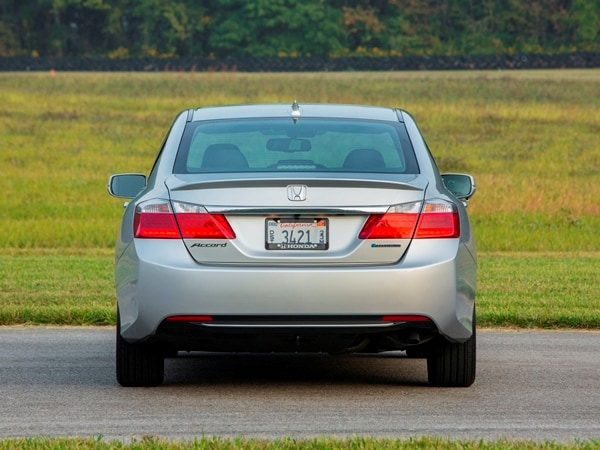
Hitting the big 5-0
You're probably wondering how this Accord can go up to 14 more miles per gallon of gasoline. In a word, it's complicated, and not in the way a younger generation describes their relationship status on Facebook.
To boil it down, the Accord Hybrid achieves its stellar numbers through the combination of a 4-cylinder gasoline engine, 2 electric motors (one acting as a generator to feed the other), and a lithium-ion battery pack. Buyers who are technology-inclined or just inquisitive about what makes their car go may be surprised to learn that the 2.0-liter gasoline engine used in the 2014 Accord Hybrid spends most of its time not directly driving the front wheels but instead powering the generator, which in turn provides energy to charge the battery or enables the electric motor to power the front wheels. At freeway speeds, though, the Atkinson-cycle gasoline engine can directly drive the wheels for maximum efficiency. We told you it was complicated.
Here's what isn't: The way the 2014 Honda Accord Hybrid drives. Despite all the engineering wizardry under this hybrid's hood, you probably wouldn't realize it in your everyday commute. And that's a good thing. Except for some unique badging and exterior/interior details, the hybrid version of the Accord doesn't look much different than the regular model, and the driving experience feels much the same in most regards and even better in others.
1 of the keys to a good hybrid experience is how such vehicles transition between powertrain sources, such as from purely electric power to assistance by a gasoline engine. In the 2014 Honda Accord, these transitions take place with Ninja-like covertness. When the gasoline engine turns on, it's smooth and not jarring. When it is running, there is some drone like in other hybrids, but it's not disruptive. And when the gasoline engine is off completely, such as when you're traveling on stored electricity, this Accord becomes remarkably serene. It shouldn't come as a surprise that the Accord Hybrid is no rocket, but with a combined 196 horsepower (compared with the regular Accord's 185 hp), the 5-passenger sedan gets up to freeway speeds with little drama. Like the regular 4-cylinder model, the Accord Hybrid delivers a pleasing combination of comfort and nimbleness. Unlike some hybrids, the Honda's brakes feel natural and not "grabby."
Thankfully, Honda's 2-Motor Hybrid Intelligent Multi-Mode Drive (i-MMD) System is easier to use than it is to say. While you can manually switch to EV mode to travel short distances on electricity alone or shift to "B" mode to capture more regenerative energy from the brakes, all most drivers need to do is push the Accord Hybrid's start button, put the gearshift into drive and go on their fuel-efficient way.
And here's the takeaway from our test-drive: We easily hit that vaunted 50 mpg mark without really even trying. In fact, after spending hours in the new Accord Hybrid and driving on a variety of roads, we averaged fuel economy in the low 50-mpg range. Our initial experience was, like the Accord itself, seamless and natural. We didn't have to "hyper-mile" to achieve 50 mpg by sweltering in the Texas heat with no A/C or by babying the throttle. We just drove normally and the Accord's hybrid powertrain figured out the rest.
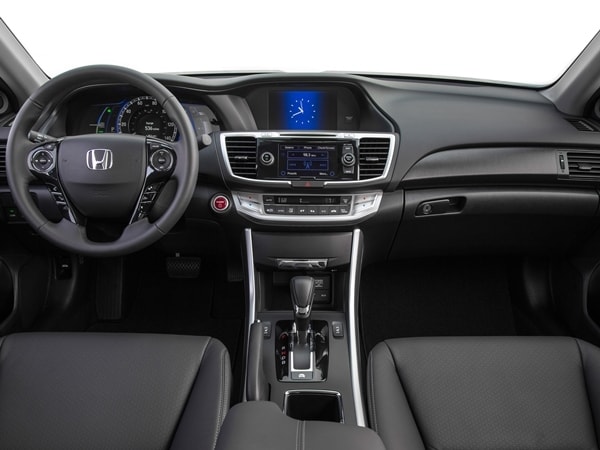
Counting the costs
The 2014 Honda Accord Hybrid has raised the bar among its peers, but its refinement, stellar fuel economy and added features cost more upfront. With a starting MSRP of $29,945, the 2014 Accord Hybrid is more expensive than hybrid variants of the Toyota Camry (starting at $26,950), Ford Fusion ($26,995), Hyundai Sonata ($26,445) and Kia Optima ($26,700), but the Honda comes standard with features such as the LaneWatch blind-spot monitoring system and rearview camera not found on base versions of its competitors. Like its rivals, the hybrid Accord is also several thousand dollars over its gas-only siblings, with a base Hybrid costing $3,475 more than a comparatively equipped Honda Accord EX. If using the EPA's standards of 15,000 miles per year at current gasoline prices, it would take more than 5 years to make up that difference if solely considering our example's fuel costs alone. For some buyers, this may be the end of the equation.
Yet there are factors beyond this moment-in-time comparison. Like the regular Accord, we expect the hybrid model to retain its value very well. Additionally, we predict the Accord Hybrid will bring a dollar premium of $1,500 to $2,000 over non-hybrid models as a used vehicle. Then there are purchase motivators that have nothing to do with what shows up on a calculator, such as environmental considerations and the feeling of being "green." 1 we experienced came when, after driving for some time, the Accord Hybrid's computer estimated we still had over 700 miles of range, easily trumping the car's EPA-estimated range of 673 miles. Can you put a price on the ability to regularly sleep in an extra 15 minutes because you don't need to stop for gas on the way to work?
The Honda Accord Hybrid obviously won't be for everyone. Its higher upfront price will exclude some buyers, while others may shy away due to more minor tradeoffs such as a smaller trunk compared to a regular Accord and the inability to fold the rear seats because a battery pack hides underneath them. But for those contemplating a family-friendly hybrid sedan, consider the 2014 Accord Hybrid the new benchmark.
#3731
Safety Car
Does the all-new 2014 Honda Accord Hybrid really get 50 miles per gallon? And does it drive as well as a regular 4-cylinder Honda Accord?
To cut right to the spoiler: yes and yes.
For some shoppers who already know and like the Accord, that might honestly be enough—once they run the numbers and see that this is a car for which hybrid ownership will make fiscal sense. Fortunately, we have many more meaningful impressions and numbers to share, as we just returned from spending most of a day with final, production-spec variants of the 2014 Honda Accord Hybrid, which will be Ohio-built for the U.S. and begins reaching dealerships late this month.
If you haven't read our explanation of how the 2014 Accord Hybrid powertrain works without any conventional transmission, you'll want to. In short, the Accord skips it all—even the torque converter and drive clutch—and moves with a system of two nested motors, of which one is mainly a generator and the other is for propulsion. The generator is always connected to the gasoline engine, while that engine only sends power directly to the wheels at steady highway/cruising speeds, when a clutch pack connects it.
The rest of the time, the propulsion motor delivers power to the wheels either from the generator (run by the gasoline engine), the 1.3-kWh battery, or a combination of both. And energy, of course, is recovered when coasting or braking.
What seems puzzling at 1st is in truth a remarkably elegant solution. And friction reduction is the real benefit; by eschewing conventional transmissions and relying on direct/gear drives, the setup cuts friction by about 70%, overall.

More like a range-extended EV?
So how does such a system drive? The best way to describe it is responsive and linear, like an electric car—sometimes quiet, sometimes with a completely out-of-sync gasoline-engine soundtrack.
2 of typical driving scenarios feel particularly odd at 1st. 1 of them is in moderate acceleration. You take off from a stop, and the Accord Hybrid steps off quietly with its electric motors only. Then as speed gathers, you hear (but don’t feel, thankfully) the gasoline engine start up and rev, to deliver (combined with the battery) enough power to the propulsion motor.
From the driver’s-seat, there’s not always a direct momentary connection between those revs and the level of acceleration. Although full-throttle acceleration can bring out a sort of 'motorboating' sound as with a CVT, it's different in most other cases. If you’ve driven the Chevrolet Volt after its charge has been exhausted, it’s closer to that; give the accelerator a push and the vehicle moves forward responsively, with the gasoline engine revving up a moment later; lift off the gas and it’s left revving for a second or 2, charging the battery and giving you a buffer to 'get back on the gas.'
The other strange sensation happens when you're cruising at steady speed (of say 60 mph) and you floor the accelerator to pass. You momentarily feel the motor system give the tall-geared gasoline engine a respectable wallop of supplemental torque, but as you keep your foot pegged, a fraction of a second later the gasoline engine decouples from the drive wheels and races to its upper ranges, sounding like a very quick-reacting CVT, all as a much stronger kick of acceleration is felt—as delivered, again counterintuitively, by the electric motor that's connected directly to the wheels.
The figure that matters the vast majority of the time is that the electric motor system can deliver up to 226 pound-feet and 166 horsepower. Having acceleration (almost) always handled by the electric propulsion motor altogether makes it feel very linear and predictable—especially if you can ignore the sounds from the gasoline engine.
That 141-hp, 2.0-liter 4-cylinder i-VTEC gasoline engine, by the way, is noteworthy not just for being Honda's first Atkinson-cycle engine but for being the most efficient internal combustion engine in the world.

High mpg without hypermiling
Anyone who’s spent a lot of time driving a hybrid vehicle knows that there’s a familiarity curve. After you get to know the system and the displays, and anticipate behavior like when the gasoline engine might turn on, and how much all-electric operation you have, you may start to ‘game’ the system, and modify your driving.
The problem is, traffic doesn’t necessary follow those patterns—and the sluggish starts and pulsing-and-glide business you might need to do for the highest numbers might be enough for road rage. Or, perhaps, driving as gently as your hybrid demands is actually adding to your own anxiety level.
And to that, we can report that we saw great mileage in the Accord Hybrid—and met the EPA Combined estimate, coincidentally—by merely driving normally, with traffic (and actually with some rapid starts and exuberant driving at a few points). Averaging results from me and another drivers over about 130 combined miles, we saw 47 mpg.
To conduct a couple of experiments, we then took the Accord Hybrid on 2 back-to-back runs of the same vehicle on the same 13.3-mile suburban loop, with lots of traffic lights and cruising speeds of 30 to 55 mph. Turning off the A/C and driving very gently—no less than 5 under the limit, and never blocking traffic—we saw more than 72 mpg (returning with the battery at about the same level). With the same car, we headed out with the A/C set cold, taking off full throttle as many times as we could (the electric motor system has tire-scorching torque off the line), driving much faster, and not braking in a smart way, we returned with an average of nearly 37 mpg.
From that (provided our trip computer was accurate), we're quite convinced that very few, if any, drivers are going to see running averages below 40 mpg. We're of course eager to see how well we do in a follow-up drive, on familiar drive loops.

As pleasant-driving as other Accords, for the most part
If you can manage to set the powertrain and mileage thoughts aside for the moment, the Accord Hybrid steers, rides, brakes, and functions—most of the time—much like any Accord. And Honda has introduced some special measures to make sure that they're smooth.
Hybrid models get a new all-aluminum subframe, along with a liquid-sealed subframe mount that helps quell vibration, while the suspension components have been bolstered in back for the addition of the battery pack (about 155 pounds together with the power control module). Active noise control provides yet another measure of quietness inside the cabin.
All Accord Hybrid models get dual-path, amplitude-reactive dampers that help damp any harshness introduced by the hybrid system’s additional weight—and altogether, the Hybrid drives better because of it. The steering doesn't feel quite as crisp at turn-in as in the other Accord models—possibly a result of those different dampers, or the somewhat less sticky run-flat tires. But overall, its handling is surprisingly engaging—far more so than the Toyota Camry Hybrid, for instance.
The Accord Hybrid’s braking system is a special electric-servo regenerative system that follows technology developed originally for the Fit EV. And it’s excellent here. Among hybrids, we think it’s the best-coordinated yet, with absolutely none of the grabbiness you have in some hybrid systems when you press lightly at lower speeds or the unpredictable lurching you get from some other systems in the last several feet of a stop.
The back seat of Hybrid models is just as roomy as that of other Accords, but rear seatbacks don't fold forward and trunk space is cut to 12.7 cubic feet—still enough, we'd think, for a large grocery run.

Simple, straightforward interface
Compared to what's offered in Toyota vehicles, as well as to Ford's interactive customizable displays, we found the displays and guides in the Honda Accord Hybrid to be refreshingly simple—with gauges for battery level and fuel level off to the right and a charge/boost gauge to the left. The center, reconfigurable area can display a number of trip-computer readouts, show a dynamic power-flow schematic, or even display navigation prompts (if so equipped). For those competitive types, there's also an Eco Guide and Eco Score system, with arcs that advise you momentarily on driving style.
The shift knob is conventional—nothing bewildering or exotic—but there’s an EV Mode button just aft of it on the center console, and if you press it when you’re driving within light-load conditions the Accord Hybrid will run with the gasoline engine off until you either run the battery to a low point or press the accelerator to a certain point for more power. Once you have, you’ll need to back off and again press that button.
There is an Econ Mode button over to the left side of the instrument panel; just as in most other new Hondas it softens powertrain response, as well as runs the air conditioning and climate control at a more conservative setting.

The highest-mileage mid-size gasoline sedan, not counting plug-ins
The EPA ratings for the 2014 Accord Hybrid are impressive: 50 mpg city, 45 highway (and 47 mpg Combined)—the highest EPA rating of any 5-passenger, 4-door hybrid sedan.
Visually, there are only a few minor cues to differentiate the hybrid. Blue accents have been added to the grille and a few other areas around the exterior; there's a special rear spoiler and diffuser; and Honda is introducing a special 'aero' wheel design. The Hybrid also gets its own exclusive gauge cluster, and the steering-wheel is finished in a gloss-black finish.
Features in the 2014 Accord Hybrid essentially parallel those in the main Accord lineup. The long list of equipment included in the base Hybrid EX include dual-zone automatic climate control, a ten-way power driver's seat, Smart Entry and Start, Bluetooth, Pandora integration and SMS text capability, a 6-speaker sound system, and a rearview camera system with LaneWatch blind-spot display. EX-L models add Forward Collision Warning and Lane Departure Warning systems, leather, premium audio, a moonroof, heated front seats, a memory driver's seat, and a HondaLink touch-screen system. Top Accord Hybrid Touring models are differentiated by their voice-recognition navigation system, Adaptive Cruise Control, and HomeLink universal-remote system.
Is the 2014 Accord Hybrid worth it, versus a Camry Hybrid or Fusion Hybrid? The Accord Hybrid is especially compelling in its top-of-the-line Touring form. While the price differential between the EX 4-cylinder and EX Hybrid is more than $7,000, the Hybrid Touring starts at just $1,425 more than a V-6 Accord Touring and a Hybrid EX-L costs only about $2,600 more than a 4-cylinder EX-L.
Really what it comes down to is whether or not you can love this very responsive, pleasant-driving car that happens to have an off-kilter soundtrack.
Honda has started from scratch and created a new hybrid system that might just to get better real-world mileage than all the rest. Added to the goodness of the Accord, we think that's a winner.
#3732
You'll Never Walk Alone
iTrader: (1)
Join Date: Jun 2005
Location: Vancouver, BC, Canada
Age: 37
Posts: 9,493
Received 835 Likes
on
519 Posts
Thanks for posting these reviews. Seems like all of them are very positive reviews. It also looks like under normal driving circumstances, the Accord Hybrid has no problem meeting its EPA ratings. In fact, it sounds quite easy to get better than 50mpg.
#3733
Safety Car
#3734
6G TLX-S
Honda is back into the hybrid game. 

#3735
so the Touring hybrid also gets the LED headlights but no fog lights? I don't want to do the whole useful/not useful argument about fogs again, but it looks so empty down there without them in a top of the line model.
#3736
Safety Car
If things go as planned, the days of Honda’s hybrids playing second fiddle to Toyota may be coming to an end.
The 2014 Accord Hybrid will be launched the last day of this month, and its full hybrid technology innovates beyond the class-leading Toyota Camry Hybrid by enough of a margin that mainstream media have written things like Honda is aiming to dethrone the Prius.
Secretly, Honda may have such aspirations, but when we asked how he thought the Accord Hybrid would do sales-wise, last week, its Executive Vice President of U.S. sales, John Mendel modestly said he’s taking a wait-and-see approach.
And if Honda is to eventually dethrone the Prius, it will need to get the Accord’s tech into actual Prius competitors. More realistically the Accord Hybrid is positioned against hybrid sedans from Toyota, Ford, Hyundai, and Kia – and represents a powertrain formula that could lead Honda out of hybrid also-ran status.
Honda will continue for a while with Integrated Motor Assist (IMA) mild hybrids carried forward this year, but the Accord Hybrid indicates Honda has otherwise learned much. And it knows it, as company reps have been drumming into the media’s collective cerebral cortex the happy refrain of the Big-5-O.
That is, 50 mpg, its official U.S. EPA city rating that’s so much better symbolically than 49. The car is also rated 45 mpg highway, and 47 mpg combined. For sure, 47 is a sizable jump over the 41/42 combined for the Camry Hybrid models – and not lacking meaning either – it’s the same number which Ford has boasted for its Fusion Hybrid.

While there’s doubt how easy the Ford can touch 47 mpg, we’ve seen it in the new Accord Hybrid and then some.
This happened last week in San Antonio, Texas, where mid-40s were attained on the highway with only mild care, and – with much greater care – a contest saw a journalist cresting over 66 mpg on a combined driving route, and over 85 mpg on a city route.
As always, the heavy footed can plummet below these heights, but the potential is there.
Leapfrogging The Leaders
The Accord Hybrid is essentially based on the limited-market 2014 Honda Accord Plug-In Hybrid without ability to plug in. It lacks the 6.7-kwh battery of the over-$40,000 plug-in, but shares the rest of its 2-Motor Hybrid Intelligent Multi-Mode Drive (i-MMD) system, for which Honda is keen to observe advantages.
“No one else is doing hybrid propulsion quite like this,” said Koji Ninomiya, chief engineer for the Accord Hybrid.

And he’s basically right. Under most conditions the i-MMD system utilizes the gas engine to power a generator, which in turn provides energy to charge the hybrid battery and/or for the electric motor to drive the wheels.
The paired propulsion motor and motor generator effectively serve as a 6-speed transmission that simulates stepped gear ratios in lower speeds, and in its lock-out mode at higher speeds, it simulates sixth.
The drive system is connected via a clutch to the engine, and a Honda rep admitted the 6-speed “Electric Continuously Variable Transmission (E-CVT)” is a essentially a misnomer.

Paired Propulsion motor and motor-generator serve as the transmission in this electrified car. A Honda engineer said only 1 other vehicle uses similar tech – the Mitsubishi Outlander Plug-in Hybrid. Another knowledgeable observer said Mitsu’s system for its all-wheel-drive SUV is not as elegant and compact as the Honda solution.
The system also takes advantage of “the world’s most efficient mass produced gasoline internal combustion engine” said Ninomiya.
More specifically, the 2.0-liter i-VTEC inline-4 running on the Atkinson cycle offers 214 g/kwh of 87-octane gasoline, which is the highest thermal efficiency of any mass produced engine Honda has seen.
Its compression ratio is 13:1 and it contributes 141 horsepower at 6,200 rpm, and 122 pound-feet torque at 3,500-6,000 rpm.
The aforementioned propulsion motor it’s mated with is a 124 kilowatt AC synchronous permanent-magnet motor delivering 226 pounds-feet from zero rpm.
This motor is powered by the engine turning the paired motor generator, along with a 1.3-kwh li-ion battery.
Maximum system output is 196 horsepower, good for mid-7-second 0-60 mph runs.

3 Operating Modes
EV Drive Mode
The default upon startup is all-electric with the gas engine decoupled and this means of operation is not unlike how the Chevrolet Volt – or a diesel-electric freight train for that matter – operates in concept, efficiently using the combustion engine as a generator in series hybrid mode.
It operates at a sedate pace, at lower speeds and when braking and is 1 of the chief innovations Honda is using to achieve mpg a notch or more above competitors.
Hybrid Drive Mode
As speeds increase, or under harder acceleration, or simply when the battery needs to be recharged after its brief range, the electric motor and gas engine work as a pair.
In this mode, the front wheels are turned solely by the electric motor – acting, as mentioned, like a transmission.
At the same time the decoupled gas engine powers the generator motor, which in turn charges the battery. In turn again, the battery may supplement the propulsion motor as needed and as able.
Engine Drive Mode
At medium to highway speeds, this mode sees the lock-up clutch connect the generator motor (always linked to the engine) and the electric drive motor to send power directly from the engine to the front wheels. This is gas-only mode, and here that “world’s most efficient mass produced gasoline internal combustion engine” propels the car while maintaining battery charge.

The rest of the car is all 9th-generation Accord in its design and styling, excepting only for hybrid badging, nicely designed, and easy to read hybrid-specific instruments, strategically placed blue accents on the exterior, and model-specific alloy wheels.
Trim Packages: Premium, Better, Better Still
For all the talk about miles per gallon, the Accord Hybrid is 1st an Accord. While you’ll hear quibbles with any new intro, the evolved iteration of the long-established nameplate does not really disappoint in operation as an effective mid-sized sedan.

In fact, Honda is packaging the Accord Hybrid in 3 trim levels with the base being an “EX” level. Officially called merely the “Hybrid,” Honda’s people confide it’s an EX, a designation that has traditionally denoted a premium model.
And it is premium, but that’s where the Accord Hybrid line starts. Above this, Honda offers the EX-L which is even more thoroughly equipped, and there’s a level above that called Touring.
How It Functions
Our experience began with a Touring edition and we drove a mixed route of highway and secondary roads.
Starting out in EV mode, the car pulls away on par with a Camry Hybrid, navigating with ease.
Power steering is light and predictable, ergonomics can be comfortably set up, and the seats are supportive.

Bumps are smoothed acceptably despite – or even because of – the couple hundred pounds of extra curb weight of the Hybrid over regular Accord. The Hybrid uses what Honda bills as Amplitude Reactive Dampers, an upgrade to its McPherson Strut Front, Double-Wishbone rear suspension.
The base “Hybrid” weighs 3,550 pounds, the EX-L weighs 3,595 and the Touring, 3,602 pounds. This is within a hundred or so pounds of the competitors.
Over some choppy pavement, a bit of harshness does get through, but the car is otherwise controlled and comfortable.
Pressing the accelerator hard will engage the engine. 1 tester said the car was hushed, while another said the engine was relatively noisy. To allow evaluation of this and other points of comparison, Honda had confidently brought in competitive cars – Camry Hybrid, Hyundai Sonata Hybrid, Kia Optima Hybrid, Ford Fusion Hybrid.

The Accord Hybrid’s engine can be heard from the driver’s seat, but the noise was not obnoxious to our ears, and actually, the car can be pretty quiet.
Otherwise, power delivered from the gas engine or motor was not detectable for how seamless it was toggling between sources, and the instruments indicate it likes to stay in EV mode as much as possible.
Honda also has an EV button to select this mode if you’re in parallel hybrid mode. It only works if there is enough battery charge, and rate of acceleration is not too great.
Driving with less than a hypermiler’s effort on a highway route, occasionally and mildly testing acceleration, and velocities, the on-board mpg instruments said we averaged nearly 44 mpg on 1 run, and low 45s on another.
We suspect the higher you go over 65, the more the impressive mpg figures will fall. Plus, if a driver likes to jackrabbit start and speed, low 40s and mid to upper 30s may likely result.

Braking action from the electric servo regenerative system offers a solid feel. Like a traditional system, it’s fully hydraulic from the master cylinder all the way to the calipers.
Lifting off of the accelerator initiates the regenerative action and the electric drive motor slows the vehicle before the friction brakes engage.
This system should extend pad life as the brake pedal signals the Electronic Control Unit (ECU) to determine braking force assigned to regenerative braking by the motor and friction brakes.
In milder stops, Honda says the friction brakes may not engage until 5 mph and below. In harder stops, the ECU initiates a chain reaction of commands to brake system components, proportioning friction brake energy to each wheel.
You don’t feel it as any sort of artificial system, and it basically works like normal.
Like other alternative-energy cars, the Hybrid also has a B transmission mode that accentuates regen action and as an alternative to regular D.
As for the super mileage reported, we can take no credit for that as during a rushed afternoon, we were elsewhere working on another project when Honda held its mpg test.

These are the actual results tallied. The winner of the city cycle said he actually got 85.2, but his 82.5 recorded was enough. Both winners got a $250 gift certificate to SkyMall and Honda got some nice press for its whimsical prizes no 1 would ordinarily buy for themselves, as Honda said.
Among the half-dozen journalists who participated, everyone beat the EPA numbers. The worst on the “combined” loop beat the EPA’s city number with 51.5 mpg. The worst on the “city” loop did even better at 59.7 mpg.
This is encouraging. On the intro to the 2012 Camry Hybrid, on what was a longer and probably tougher route for mileage, HybridCars.com’s Larry Hall hit 58 mpg his first time out, and that was considered a decent run among peers.
Anyone remotely following hybrid cars knows the 2013 Fusion Hybrid has polarized buyers, and Ford has been sued by those alleging it embellished its mpg claims. The 2 Korean cars have also had similar issues, are rated for less mpg, and less likely to hit into the stratosphere.
That plenty of people have proven the Accord Hybrid’s ability to even transcend its official estimates is a feather in Honda’s cap.
Market Positioning
Honda clearly has technology poised to convince more people to go hybrid. Its pricing strategy however aims at an upper-level demographic that eschews plain Jane trim levels.
The company says the household income for its projected Accord Hybrid buyers is over $90,000 annually, and folks in this bracket ought to have no qualms opting for a “50 mpg” sedan that starts (including $790 destination) at $29,945 (Hybrid), ascends to $32,695 (EX-L), and then to $35,695 (Touring).
Honda is quick to observe a high degree of standard content included at each level should be factored when comparing prices to the competitors. All the competitors start in the mid to upper-mid 20s and can be optioned up to Accord levels.
As for how they drive, overall we liked the Accord’s road manners, fit and feel essentially the best, but they all have their redeeming qualities, and the Camry Hybrid frankly remains an arguable alternative.

And here’s where we sign off, and leave it up to buyers to ideally test drive prospective purchases, and decide what’s most important to them.
We will add – despite Honda citing market studies to the contrary – that we still wonder whether Honda could sell sufficient quantities of a somewhat less-fully contended Accord Hybrid albeit with core Accord competencies, plus great mpg.
We also pondered whether Honda does not want to cannibalize its regular Accord sales?
That is unknown, as is how the market will go for a premium-content technological winner – that knows it, and is priced accordingly.
Our bet is the Accord Hybrid will have to overcome Toyota’s years of perceived superiority, but stands to rank solidly in the mix as word gets out.
Honda would be well served to get this technology into more models as soon as feasible.
#3737
▒JDM ¥ KING▒
This car is a huge turning point in Honda history.
I'm hoping TLX to be a global model, same like TSX, and also to be a complete package.
I feel that 3gen TL success will be repeating with TLX.
I'm hoping TLX to be a global model, same like TSX, and also to be a complete package.
I feel that 3gen TL success will be repeating with TLX.
#3738
Safety Car
The 2014 Honda Accord Hybrid should surprise no 1. Its look is something we've seen since the non-hybrid versions went on sale last year. Its powertrain, mostly, we are familiar with from the already-on-sale Accord Plug-In model. And the overall vibe of the car? Well, it's an Accord, which has been a strong seller in the US for 3 decades, so much so that there's a very good chance you've been in 1 at some point, whether you noticed or not.
Honda's 1st attempt at an Accord Hybrid, released in 2005, put dynamic performance 1st, but it didn't match the public's maturing perception of what a hybrid is all about: fuel economy. The 2005 version was capable of a measly 28 miles per gallon combined, 25 in the city and 33 on the highway. Remember those numbers, and that the 1st-generation Accord Hybrid lasted all of 3 model years before being axed.



Despite all that, the idea of an Accord Hybrid makes sense, especially in an era of tightening fuel economy regulations. After all, Honda sells around 350,000 Accords a year, and improving the fuel economy of your most mass market vehicle, even by a little, makes a big difference when you're concerned about the "A" in CAFE. While Honda won't say what percentage of Accord sales it expects the Hybrid to make up – "We'll sell as many as we can" was the refrain – the addition of the 50/45/47 (city/highway/combined) Hybrid version means Honda finally has a deep lineup of powertrains and trim levels for this 9th-generation Accord family, with prices that range from $21,955 for the base standard version to $39,780 for the Accord Plug-In.
The Accord Hybrid starts roughly in the middle at $29,155, though doesn't in any way feel $10,000 cheaper than the Accord Plug-In, in part because its non-EV mileage figures are actually better than its more expensive brother (except for a 1-mpg win by the Accord Plug-In on the highway). The reason lies in the near-identical powertrains the 2 cars share.




So, let's start there, with the powertrain. It's a complicated mess to understand if you're not a Honda engineer (and maybe even then), but it's a complicated mess that works well. We got our 1st introduction when we drove the Accord Plug-In model a year ago. The engine and the 2-motor setup are the same and, in fact, the powertrain differences are limited to battery size (6.7 kWh in the plug-in and 1.3 kWh in the hybrid) and software. That bigger battery pack means the Accord Plug-In offers more electric-only range, up to 13 miles. The maximum EV range of the Accord Hybrid depends on the battery level, but it will be a rare situation indeed when you get more than 1combustion-free mile out of the car – after letting the regenerative brakes do their thing over a 2-mile downhill, for example.
Honda is using the same powertrain in both cars because the whole thing is part of a bigger mission to improve efficiency throughout the lineup, known as Earth Dreams. In its hybrid portfolio, Honda has mostly gotten rid of using the older nickel-metal hydride batteries. Along with the Accord Hybrid, the Civic Hybrid, CR-Z, and Acura ILX Hybrid all now use newer lithium-ion batteries. Only the forgotten Insight carries around the older NiMH technology. When it comes to Earth Dreams hybrids, the Japanese domestic market Fit Hybrid uses a 1-motor system and some upcoming performance vehicles like the NSX will get a 3-motor system. The 2-motor setup, though, is all-new in the gas-electric Accords, and is accompanied by a 2.0-liter, 4-cylinder DOHC i-VTEC Atkinson Cycle engine with a maximum output of 141 horsepower at 6,200 rpm and 122 pound-feet of torque. The 2 motors, meanwhile, have a combined maximum output of 166 hp and 226 lb-ft.

The Honda Accord Hybrid is the first application of this two-motor system, but it will not be the last. Honda calls it Intelligent Multi-Mode Drive (i-MMD), and it is very different than the Integrated Motor Assist (IMA) system used in other Honda hybrids we know in North America.
The key to the new powertrain is its "multi-mode" nature, which allows the Accord hybrids to move down the road using only their electric motors (powered either from the battery, called EV Drive, or from electricity generated from the on-board gasoline, called Hybrid Drive) or directly by the gasoline engine (called, unsurprisingly, Engine Drive) once you get above around 43 or 44 miles per hour. That doesn't mean the Accord Hybrid is being driven by the engine alone any time you're going 45 mph or more. It can go up to 70 mph on electricity running through the motors, but it's up to the software to decide when to draw power from where, depending on the demand for acceleration, battery state of charge and other factors. While there is an EV button that encourages as much electric distance as possible, there is no way for the driver to choose one drive setting over the other. The car simply picks whatever is best to maximize fuel efficiency.
Another complicating angle is the fact that there is no traditional transmission gearbox or even a torque converter involved. Instead, the 2 motors and a lock-up clutch act like an electric CVT (the kind both Toyota and Ford use in their hybrids) and, when the engine is powering the front wheels directly, like a fixed 6th gear. The benefit of all of this reduced complexity is fewer moving parts – and thus lighter weight and less friction – in a powertrain that can still deliver a maximum combined output of 196 hp along with an impressive 50 mpg in the city.


As you drive, which Honda invited us to do in the hills and highways around San Antonio, TX recently, all of that complicated shifting happens without so much as a "hi-how-are-you?" Lovely and instant electric torque is available when you get going, but instead of that great EV silence when you stomp on the gas, an engine whine that will sound familiar to Prius drivers filters its way into the cabin. When you're not demanding much acceleration (that is, most of the time in daily commuting), you won't notice the engine kicking in or turning off. We spent more time paying attention to the nicely weighted steering that kept us true on the highway but was responsive enough that we felt we could avoid any surprised that might dart out into the road.
If we couldn't swerve quickly enough, the brakes also felt rock solid, and Honda has done an excellent job blending the regenerative and traditional friction methods. The electric servo brake system was originally designed for the Fit EV, and the motor does all the braking up to a brake force of 0.2 G. If you go above that, and when you come to a full stop, the friction brakes kick in. The MacPherson struts in front and independent multilink suspension in back kept us stable and confidently in contact with the road at all times. The Accord Hybrid (3,550-pound curb weight) is 250 pounds lighter than the 3,799-pound Plug-In Hybrid (thanks, smaller battery) and about 350 pounds heavier than the lightest gas-powered Accord (3,192 pounds). Weight isn't everything when it comes to handling, but the middle-of-the-pack gas-electric does not massively alter the engaging driving dynamics compared to the other models.

From the driver's seat, where we couldn't get the adjustable lumbar support to feel quite right, the first thing we noticed was the Honda's great visibility. The pillars don't get in the way too much no matter where you look. The outside edge of the left mirror is curved in a way that will be familiar to Europeans and shows off more of what's behind you, and even the base model features Honda's excellent LaneWatch camera that shows your right side blind spot in the dashboard display when you're turning or changing lines to the right (view it in action in our Short Cut video below). We liked it in the Accord Plug-In and we like it here.
There are other nice touches, like a cool 'floating' speedometer indicator (really, just a u-shaped part) that leaves room inside the ring of numbers for a display screen. The infotainment system in the base model we drove wasn't anything special, but served us just fine. We didn't like the way the system wasn't able to display our iPod album art for a few seconds at the beginning of each song, but this is a minor complaint. The most useful screen was the fuel economy readout, showing us a record of our current trip and recent ones to see if our driving was getting more efficient or less. On our 30-mile non-highway route when we didn't baby the vehicle, we got 38-39 mpg. A minor adjustment into very light coasting and gentle starts quickly pushed that figure up to 47, and other journalists who were trying to win Honda's efficiency challenge for the day managed to get the in-dash display to show over 80 mpg. Your mileage may vary, as always, but we preferred using air conditioning in the Texas heat. We're fancy like that.



Standing in that heat while looking at the car, you notice the hybrid-specific touches, like exclusive 17-inch aero-style wheels, new LED-trimmed headlights and blue accents around the grille. Inside, the only difference is a gloss black steering wheel finish (instead of matte) and a different multi-information display to give out hybrid-specific details. Put it all together and you realize you don't have to give up anything, really, from the standard Accord, other than losing three cubic feet of cargo space to accommodate a larger battery. Oh, and rear folding seats, which is an unfortunate packaging reality from the company that has those clever Magic Seats in a car as small as the standard Fit.
Which brings us back to figuring out where the the Ohio-built Accord Hybrid fits. The 50-mpg number could catch the eye of Prius owners who are used to believing the only way to hit that number is in their gas-electric hatchback. What's significant about Honda's package is that it starts under $30,000. That doesn't make it the cheapest hybrid on the market, but for a car this size, achieving 50 mpg for $29,155 is impossible otherwise. There are some real contenders in the Accord Hybrid's segment – Toyota Camry Hybrid, Ford Fusion Hybrid, Hyundai Sonata Hybrid – but none of them can claim that level of fuel economy. The Fusion comes closest, officially, but we all know the problems Ford has had with its EPA ratings. The rest are all around 10 mpg worse.
There are three trim lines for the Accord Hybrid. The base model we drove (Hybrid) comes standard with things like USB ports and an eight-inch screen, but does not have any navigation information to display there. You don't get that even in the mid-level EX-L trim ($31,905), where you do get heated front seats and two nice safety features (warnings for lane departure and forward collision). The top-of-the-line Touring trim ($34,905) not only adds nav, but also adaptive cruise control and Honda's Homelink technology. Honda expects Accord Hybrid sales will break down this way: 45 percent will choose the Hybrid, 40 percent the EXL and 15 percent will splurge on the Touring.

We were suitably impressed by the Accord Plug-In, but Honda is doing its best to make that vehicle irrelevant with the Accord Hybrid, which makes a whole lot of sense compared to its pluggable brother – a car that is still only available in New York and California. You lose 12 miles of EV range but save $5,000-$10,000. You do pay more than you would for the non-hybrid Accord with an automatic transmission, but that only achieves 30 mpg combined (27 city and 36 highway).
When we drove the Accord Plug-In, we were told the Accord family is "Honda's most important product." When you get behind the wheel of the Accord Hybrid, it's clear that a lot of thought and engineering was considered, implemented and then made to disappear. Automakers know that mass-market buyers are not interested in complicated powertrains or advanced MPG settings. They just want a decent-sized car that doesn't cost an arm and a leg and posts amazing fuel economy numbers. The Accord Hybrid delivers. Actually, that is kind of a surprise.
#3739
2013 Accord V6 Loses Consumer Reports Recommended Rating 

Consumer Reports Annual Auto Reliability Rankings: Japanese Dominance Cracks as Audi, Volvo & GMC Secure Spots in Top 10
In-Car Electronics Prove to be Achilles Heel for Many Models in Survey
YONKERS, NY, Oct. 28, 2013 /PRNewswire-USNewswire/ -- Japanese brands have historically been known for building some of the most reliable vehicles in the world. But Consumer Reports 2013 Annual Auto Reliability rankings show that some other automakers-from Europe and the U.S.-are also capable of building reliable vehicles. Audi, Volvo, and GMC captured three of the top-10 spots in the survey this year.
Survey results were released at a press conference today before the Automotive Press Association in Detroit.
Three Japanese brands, Lexus, Toyota, and Acura captured the top three spots in the survey, which was conducted by the Consumer Reports National Research Center. The survey is believed to be the largest of its kind; findings are based on CR subscribers' experiences with 1.1 million vehicles. Consumer Reports uses the survey data to compile reliability histories on vehicles and predict how well new cars that are currently on sale will hold up.
For more than a decade, Japanese brands have had a lock on most of the top spots in the survey. It's been rare for a European, Korean, or U.S. carmaker to achieve anything higher than seventh or eighth place.
But Audi, which has shown steady improvement in vehicle reliability during recent years, moved up four places this year to finish fourth overall-the top European manufacturer in the survey. Three Audis, the A6 sedan, Q7 SUV and Allroad wagon, have "much better than average" reliability. Volvo jumped 13 places to seventh. GMC emerged as the top domestic brand, finishing ninth-three places higher than last year. Moreover, every model from Audi, GMC, and Volvo, for which CR has data, earned an average or better reliability score.
The top predicted-reliability score went to the redesigned 2014 Subaru Forester SUV, which hadn't been on the market for very long when CR conducted the survey. The Ford C-Max Energi plug-in hybrid got the worst score, and the regular C-Max Hybrid wasn't much better.
General Motors fared better than other domestic brands. In addition to GMC, Buick climbed nine slots to 12th place over last year. All Buicks except the V6 LaCrosse were average or better. The only dark spots for Chevrolet are the Camaro and Cruze, both of which earned below-average reliability scores.
Japanese brands took seven out of the 10 top spots in the survey. Nissan sank to 22nd among the 28 brands in the rankings. As a group, the nine Japanese brands in the survey still produce a remarkable number of reliable cars. Of the almost 100 models, 90 percent were average or better and almost a third of them received top marks. Ten of those highest scorers were Toyotas. Of the eight Lexus models in CR's survey, six got top marks. All Lexus and Acura models earned an above average reliability score while all Infiniti, Mazda, and Toyota models earned an average or better reliability score.
Two popular models, the redesigned 2013 Honda Accord V6 and the 2013 Nissan Altima, scored too poorly in the survey for Consumer Reports to continue Recommending them. Last year, CR had predicted that both vehicles would have at least average reliability.
Mazda slipped from fourth to fifth. The redesigned Mazda6 debuted with above-average reliability. Subaru and Scion, which also typically rank well in reliability, were torpedoed by their twin sports cars, the Subaru BRZ and the Scion FR-S, which scored below average. This dropped Subaru to 10th place, from last year's fifth. Scion, for which CR had only two models with sufficient data, sank from first place to 11th this time.
One of the key problem areas in Consumer Reports' survey centers on in-car electronics, including the proliferating suite of audio, navigation, communication, and connected systems in newer cars. Of the 17 problem areas CR asks about, the category including in-car electronics generated more complaints from owners of 2013 models than for any other category.
In many cases, the survey revealed touch-screen infotainment systems have been buggy, with frustrating screen freezes, touch-control lag, or a reluctance to recognize a cell-phone, an MP3 device, or a voice command.
Hybrids and electric cars continue to do well. The Toyota Prius, Lexus ES 300h, Toyota Prius C, and Honda CR-Z hybrids, as well as the Nissan Leaf electric car, were among the top models. Ford's C-Max and Fusion hybrids were the only exceptions.
The Tesla Model S electric car performed well enough in the survey to earn a Recommendation from CR for the first time. CR gathered data on more than 600 2012 and 2013 models. Owners of the 2012 model reported very few problems, although 2013 owners reported quite a few more. Problem areas included wind noise, squeaks and rattles, and body hardware (including the sunroof, doors, and locks).
Of the 31 Ford models in Consumer Reports' survey, only one, the F-150 pickup with the 3.7-liter V6, was above average. Seven achieved an average score. Ford's challenges don't end with the historically problematic My-Touch systems. Several EcoBoost turbocharged V6 models have poor reliability as well. Almost two-thirds of the 34 Fords and Lincolns in our survey got scores that were much worse than average.
Chrysler is still below par overall, but a bright spot is the very nice Chrysler 300 C which scores above average-last year it was the company's most troublesome vehicle. Unfortunately, some of Chrysler's most reliable models, such as the Jeep Compass and Patriot SUVs, didn't score well in Consumer Reports' testing, while the better performing 2014 V6 Jeep Grand Cherokee has fallen well below average reliability.
In recent years, Hyundai and Kia were beginning to challenge the Japanese at the top of Consumer Reports' reliability rankings. In 2011, they scored well ahead of Detroit and most European companies. But they slipped a bit in the 2013 survey, with Kia ranking midpack and Hyundai sliding to 21st place. BMW and Mercedes-Benz remained around midpack among all brands. Most models from those German badges are average or better, with each company having a few problem children: the BMW 335i and turbocharged six-cylinder X3, and the diesel-powered Mercedes M-Class. Volkswagen, which turned in a middling performance, was especially hampered by the trouble-prone Beetle, GTI, and Touareg. All three Minis in our survey made a very poor showing.
In-Car Electronics Prove to be Achilles Heel for Many Models in Survey
YONKERS, NY, Oct. 28, 2013 /PRNewswire-USNewswire/ -- Japanese brands have historically been known for building some of the most reliable vehicles in the world. But Consumer Reports 2013 Annual Auto Reliability rankings show that some other automakers-from Europe and the U.S.-are also capable of building reliable vehicles. Audi, Volvo, and GMC captured three of the top-10 spots in the survey this year.
Survey results were released at a press conference today before the Automotive Press Association in Detroit.
Three Japanese brands, Lexus, Toyota, and Acura captured the top three spots in the survey, which was conducted by the Consumer Reports National Research Center. The survey is believed to be the largest of its kind; findings are based on CR subscribers' experiences with 1.1 million vehicles. Consumer Reports uses the survey data to compile reliability histories on vehicles and predict how well new cars that are currently on sale will hold up.
For more than a decade, Japanese brands have had a lock on most of the top spots in the survey. It's been rare for a European, Korean, or U.S. carmaker to achieve anything higher than seventh or eighth place.
But Audi, which has shown steady improvement in vehicle reliability during recent years, moved up four places this year to finish fourth overall-the top European manufacturer in the survey. Three Audis, the A6 sedan, Q7 SUV and Allroad wagon, have "much better than average" reliability. Volvo jumped 13 places to seventh. GMC emerged as the top domestic brand, finishing ninth-three places higher than last year. Moreover, every model from Audi, GMC, and Volvo, for which CR has data, earned an average or better reliability score.
The top predicted-reliability score went to the redesigned 2014 Subaru Forester SUV, which hadn't been on the market for very long when CR conducted the survey. The Ford C-Max Energi plug-in hybrid got the worst score, and the regular C-Max Hybrid wasn't much better.
General Motors fared better than other domestic brands. In addition to GMC, Buick climbed nine slots to 12th place over last year. All Buicks except the V6 LaCrosse were average or better. The only dark spots for Chevrolet are the Camaro and Cruze, both of which earned below-average reliability scores.
Japanese brands took seven out of the 10 top spots in the survey. Nissan sank to 22nd among the 28 brands in the rankings. As a group, the nine Japanese brands in the survey still produce a remarkable number of reliable cars. Of the almost 100 models, 90 percent were average or better and almost a third of them received top marks. Ten of those highest scorers were Toyotas. Of the eight Lexus models in CR's survey, six got top marks. All Lexus and Acura models earned an above average reliability score while all Infiniti, Mazda, and Toyota models earned an average or better reliability score.
Two popular models, the redesigned 2013 Honda Accord V6 and the 2013 Nissan Altima, scored too poorly in the survey for Consumer Reports to continue Recommending them. Last year, CR had predicted that both vehicles would have at least average reliability.
Mazda slipped from fourth to fifth. The redesigned Mazda6 debuted with above-average reliability. Subaru and Scion, which also typically rank well in reliability, were torpedoed by their twin sports cars, the Subaru BRZ and the Scion FR-S, which scored below average. This dropped Subaru to 10th place, from last year's fifth. Scion, for which CR had only two models with sufficient data, sank from first place to 11th this time.
One of the key problem areas in Consumer Reports' survey centers on in-car electronics, including the proliferating suite of audio, navigation, communication, and connected systems in newer cars. Of the 17 problem areas CR asks about, the category including in-car electronics generated more complaints from owners of 2013 models than for any other category.
In many cases, the survey revealed touch-screen infotainment systems have been buggy, with frustrating screen freezes, touch-control lag, or a reluctance to recognize a cell-phone, an MP3 device, or a voice command.
Hybrids and electric cars continue to do well. The Toyota Prius, Lexus ES 300h, Toyota Prius C, and Honda CR-Z hybrids, as well as the Nissan Leaf electric car, were among the top models. Ford's C-Max and Fusion hybrids were the only exceptions.
The Tesla Model S electric car performed well enough in the survey to earn a Recommendation from CR for the first time. CR gathered data on more than 600 2012 and 2013 models. Owners of the 2012 model reported very few problems, although 2013 owners reported quite a few more. Problem areas included wind noise, squeaks and rattles, and body hardware (including the sunroof, doors, and locks).
Of the 31 Ford models in Consumer Reports' survey, only one, the F-150 pickup with the 3.7-liter V6, was above average. Seven achieved an average score. Ford's challenges don't end with the historically problematic My-Touch systems. Several EcoBoost turbocharged V6 models have poor reliability as well. Almost two-thirds of the 34 Fords and Lincolns in our survey got scores that were much worse than average.
Chrysler is still below par overall, but a bright spot is the very nice Chrysler 300 C which scores above average-last year it was the company's most troublesome vehicle. Unfortunately, some of Chrysler's most reliable models, such as the Jeep Compass and Patriot SUVs, didn't score well in Consumer Reports' testing, while the better performing 2014 V6 Jeep Grand Cherokee has fallen well below average reliability.
In recent years, Hyundai and Kia were beginning to challenge the Japanese at the top of Consumer Reports' reliability rankings. In 2011, they scored well ahead of Detroit and most European companies. But they slipped a bit in the 2013 survey, with Kia ranking midpack and Hyundai sliding to 21st place. BMW and Mercedes-Benz remained around midpack among all brands. Most models from those German badges are average or better, with each company having a few problem children: the BMW 335i and turbocharged six-cylinder X3, and the diesel-powered Mercedes M-Class. Volkswagen, which turned in a middling performance, was especially hampered by the trouble-prone Beetle, GTI, and Touareg. All three Minis in our survey made a very poor showing.
#3740
Safety Car
Honda Accord or Honda Accord? It's the kind of comparison shopping Honda dealers dream about, and a scenario that's about to happen in showrooms across the country.
Imagine it. You're on a dealer's lot or, ahem, on Edmunds.com looking for a brand-new Honda Accord. You find a nice EX-L you like. It's got the toys you want, an efficient 4-cylinder engine and an EPA rating of 30 mpg combined (27 city/36 highway). Right next to it is an Accord that looks exactly the same, with the same toys, except this car's window sticker screams 47 mpg (50 city/45 highway). It's not a typo. It's the new, 2014 Honda Accord Hybrid.
At 1st blush, the 2014 Honda Accord Hybrid looks nearly identical to the Accord we're familiar with. Handsome and reserved without a hint of hybrid smugness, the new Accord Hybrid could be the fuel-saving family sedan we've been waiting for. Or it could be another half-measure hybrid that fails not only in the face of strict scrutiny, but also against the very vehicle on which it's based. We put it against its chief in-house rival to find out.
Spoiler alert: The Blue Accord wins.
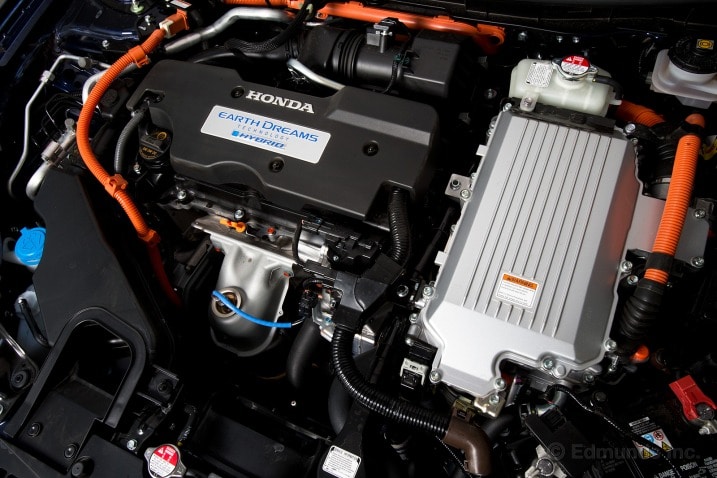
Same Accord, Different Powertrain
The fun thing about comparing cars that are effectively a trim difference apart from each other is that we only have to say things once. Heck, they're even outfitted in the same Obsidian Blue exterior paint. Beyond that, we need to dig into the nuts and bolts of Honda's naming schemes to show exactly how similar these 2 Accords really are.
The 2014 Honda Accord Hybrid is available as a base Hybrid, an upgraded EX-L and a top-trim Hybrid Touring, the latter of which we have here. The traditionally powered Accord is available in far more trims including LX, Sport, EX-L and Touring. The official trim of our tester is "2013 Honda Accord EX-L with Honda Satellite-Linked Navigation System, Continuously Variable Transmission." Right.
Here's what that means: Both cars get a leather-trimmed interior, heated front seats, 5-passenger capacity, dual-zone automatic climate control, 10-way power driver seat, 8-inch information screen, an audio control touchscreen, navigation, forward collision warning, lane departure warning, rearview camera, 17-inch wheels, push-button start and more.
The similarities extend beyond the features, too. Both cars use a very decent electric power steering system that will let you put the car where you want it to go on a twisty road, and a compliant suspension that still ties the car to the road in a confident way. At our testing facility we recorded a slalom speed of 63.7 mph for the Hybrid and 63.3 for the conventional Accord. Ignoring the powertrain, the experience is effectively the same.
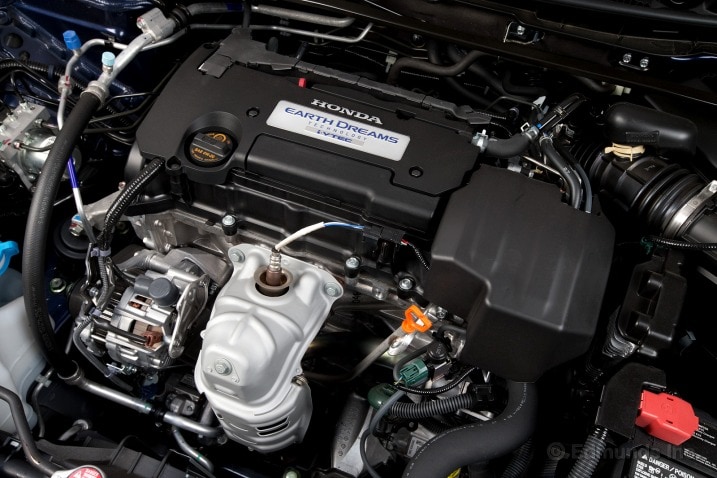
It's MPG That Matters
The big difference between the 2014 Honda Accord Hybrid and the 2013 Honda Accord EX-L? A lip spoiler on the trunk and 17 mpg.
According to the EPA, the Accord Hybrid returns 47 mpg combined (50 city/45 highway) for an estimated annual fuel cost of $1,100. The EPA estimates the 4-cylinder EX-L at 30 mpg (27 city/36 highway) for an estimated annual fuel cost of $1,750. Our testing showed the Hybrid's advantage to be even more significant.
Despite the normal exterior, the Accord Hybrid manages these numbers by being totally revolutionary under the hood.

Under-the-Hood Differences
The Accord EX-L has a 2.4-liter 4-cylinder that's good for 185 horsepower and 181 pound-feet of torque. This twist goes through the front wheels via a supremely well-tuned continuously variable transmission (CVT). It is smooth, eerily quiet, fuel-efficient and as predictable as a golden retriever. Until we drove the Accord Hybrid, we'd say that this is the powertrain most shoppers are looking for.
An Atkinson-cycle 141-hp, 2.0-liter 4-cylinder engine powered by 87-octane gasoline lies at the foundation of the Accord Hybrid's powertrain. But Honda completely ditched the Hybrid Accord's transmission and replaced it with a pair of electric motors. 1 motor acts as a generator, powered by the gasoline engine to charge the battery while the other drives the wheels. When necessary — primarily at freeway speeds — the gas engine is locked to the drive wheels via the electric motor. In place of the regular Accord's large trunk and fold-down rear seats is a 1.3 kWh lithium-ion battery. Combined power output is 196 hp and 226 lb-ft of torque.
This novel approach to power delivery allows the Accord Hybrid to run in full EV mode (up to 74 mph), series-hybrid mode (where the engine is powering the batteries that are driving the wheels) and full-on gasoline mode for those long, steep climbs. If this sounds complicated, that's because it is. But the engineers at Honda did all of the thinking so we don't have to. Just dump it in Drive and let the computers figure out where the power is sourced.
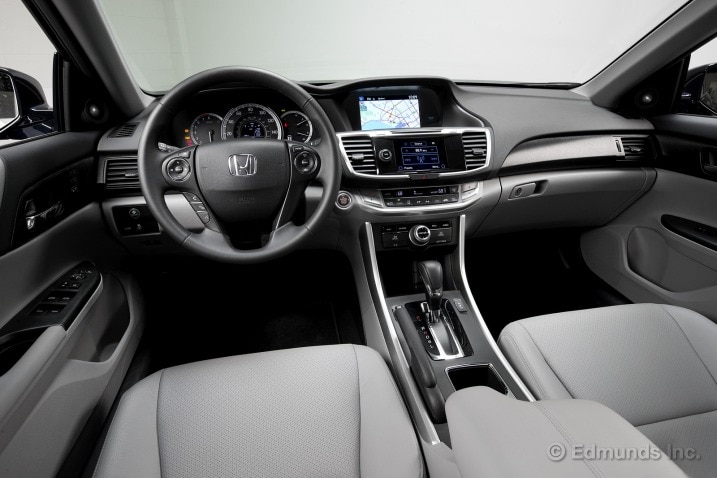
Performance
At full whack, the 3,569-pound Accord Hybrid hits 60 mph in 7.4 seconds (7.1 seconds with 1-foot rollout as on a drag strip). The 3,358-pound EX-L achieves the same speed in 7.9 seconds (7.7 seconds with rollout).
Unsurprisingly, it's the brakes that are strange. But not like you might think.
In normal use, brake feel in the Hybrid is intuitive enough. It's distinctly missing the non-linearity that plagues many hybrids. Stepping on the Hybrid's brake pedal is more like releasing the throttle on a full electric vehicle than it is like braking a normal car. The 1st 20 percent or so of pedal travel is dedicated to triggering only regeneration, so it's easy to maximize energy return without using the mechanical brakes. And it will do it all the way down to 1 mph.

When Do I Break-Even?
Perhaps intentionally, Honda jumbled its pricing/packaging offerings of the Accord Hybrid relative to the traditional car, making a straight comparison difficult. Our battery-less Accord wears the "EX-L with Navigation" designation, which simply doesn't exist on the Hybrid. To get navigation in that car, you'll need to upgrade to the Touring package, which also throws in adaptive cruise control, LED headlights and the HomeLink built-in garage door opener. That same package, which adds LED headlights and adaptive cruise control, isn't available on conventional 4-cylinder Accords, but can be had on the V6.
Our 2014 Honda Accord Hybrid tester totaled $35,695, while Honda asks $30,785 for the 2013 Honda Accord EX-L. That's a difference of $4,910. Using the EPA's numbers, which are calculated assuming 45 percent highway and 55 percent city driving, break-even happens in 7.5 years.
But things are rarely as simple as EPA numbers suggest. For starters, we didn't get 47 mpg combined out of the 2014 Accord Hybrid; we got a 46.3 mpg average over 881 miles. Our best tank, a 60/40 mix of highway and city driving netted an impressive 53.9 mpg.
The Accord EX-L didn't fare as well. We averaged 25.4 mpg over 620 miles: well below its 30 mpg EPA combined claim. The EX-L's best tank, a 36.3-mpg effort, happened on the highway-heavy 116-mile Edmunds evaluation loop. On this same loop, at the same time, the Accord Hybrid managed 47.5 mpg.
Substituting our real-world numbers for the EPA predictions changes things considerably. Using a California-average $3.60/gallon fuel price and assuming you'll drive 15,000 miles annually, the Accord Hybrid will save $986 per year. That shortens the break-even point to 5 years.
If fuel prices rise to $5.00/gallon the break-even point shortens to only 3.5 years. And, of course, you could buy the $3,000 less expensive Accord Hybrid EX-L, which forgoes navigation and adaptive cruise, and virtually eliminates any argument for the gasoline-only Accord.

2nd Place: 2013 Honda Accord EX-L
The 2013 Honda Accord EX-L doesn't do anything wrong and comes in at a lower price, so 2nd place hardly seems fair. But, sometimes you do everything right and the other guy just does it all a little better.
Honda made great strides with the 2.4-liter 4-cylinder and CVT in the current Accord. It's an effortless and unobtrusive powertrain that manages to erase any notions we had that CVTs are annoying, while returning competitive fuel economy.
But at the end of the day, it's still an internal-combustion engine and relatively conventional transmission, while the 2014 Honda Accord Hybrid is the smoothest, most seamless hybrid we've ever driven.
Of course, the Accord Hybrid won't be for everyone. There are those who are simply looking to save money now and people who question the long-term, full-cycle environmental impact of hybrids and their precious-metal battery packs. And then there's your driving cycle. Climbing grades, long freeway drives or speeds above 75 mph will severely reduce the Hybrid's lead.
Your results may vary, but we found a very clear winner...

1st Place: 2014 Honda Accord Hybrid
We want to say this was decided the minute we accidentally managed more than 53 mpg in the Accord Hybrid, but it wasn't. Rather, it was decided along California's Interstate 10 between the 405 and the Pacific Ocean. Traffic was mercifully light and the Accord Hybrid was gliding along in EV mode returning some improbable fuel economy figure.
Bolstered by a decent descent, judicious use of the engine braking feature and a careful foot, we'd actually been running on electricity for a distance that would make the Accord Plug-in Hybrid nervous. Traffic slowed to a crawl just as our battery indicator was getting low and the regenerative braking renewed some much-needed power. This experience helped us fully appreciate not only how much smoother and quieter the Hybrid is, but how much more driver involvement it offers.
It's not fun in the traditional sense, but the 2014 Accord Hybrid makes fuel economy a satisfying game. Responsive and predictable brake regeneration, visual rewards for efficient driving and the ability to alter the character of the car with your right foot separate this from previous hybrids. Without becoming a rolling chicane, affixing cardboard spats or driving a futuristic pod, it manages to pay off both at the pump and from behind the wheel.
The New Normal
We can't help but feel that this is the beginning of the end for the non-hybrid Accord. With the exception of its trunk volume and lower price, the traditional Accord lags in every meaningful measure of midsize sedans. By ditching its transmission, Honda has refined the hybrid experience to a level that traditional powertrains can't achieve.
Faster, smoother and better fuel economy? We're sold.
The following users liked this post:
Legend2TL (11-20-2013)
#3741
AZ Community Team
^ Great to see the break even point to be only 5 years of real driving.
Good comparison as well using essentially the same chassis with different drivetrains.
Good comparison as well using essentially the same chassis with different drivetrains.
#3743
I drive a Subata.
iTrader: (1)
I would get the hybrid just because the instrument cluster on Hybrid looks much better 

#3745
Safety Car
Honda Motor Co.'s Accord was named Green Car of the Year on Thursday.
The Accord won in large part because it offers high fuel economy ratings for gasoline, gasoline-battery hybrid and plug-in hybrid versions of the venerable sedan, said Ron Cogan, editor of the Green Car Journal, which organizes and sponsors the award.
"This year's winner offers something for everyone," he said.
The Accord beat out four other finalists: the Audi A6 TDI, the BMW 328d, the Mazda3 and the Toyota Corolla. Audi is a luxury brand of parent Volkswagen AG.
It was the 2nd year in a row that the winner was a top-selling sedan that offered U.S. consumers gasoline, gasoline-battery hybrid and plug-in hybrid versions.
Last year's winner was Ford Motor Co.'s Fusion mid-sized sedan.
Mike Accavitti, head of automotive operations for American Honda, said the award is an obvious selling point for the Accord.
The Accord is the best-selling of the 5 finalists. Through October of this year, Accord sales were up 11 percent at 307,000 in the U.S. market, making it the 2nd-best selling sedan behind the Toyota Camry.
"We're moving in the right direction, right?" Accavitti said to reporters after accepting the award.
The Accord gasoline and hybrid versions are made at the company's plant in Marysville, Ohio, and the plug-in hybrid is assembled in Japan.
The 4-cylinder version of the Accord is rated by the Environmental Protection Agency at 30 miles per gallon, the hybrid version at 47 mpg and the plug-in hybrid at 46 mpg under gasoline power and 115 mpg-equivalent under hybrid-electric power. All ratings are for combined city and highway driving.
Accavitti said the award also gives credence to Honda's plans for more hybrid vehicles.
"You are going to see more and more of these hybrid motors coming across our lineup."
In addition to the Ford Fusion, previous winners have included General Motors' plug-in hybrid Chevrolet Volt in 2011 and Honda's natural gas-powered Civic in 2012.
The award has been presented since 2006, when Ford won with the Mercury Mariner hybrid, a since-discontinued SUV that attained about 27 mpg and had a starting price of nearly $30,000.
#3746
Safety Car
Tell someone you drive a hybrid and they will most likely assume there's a Toyota Prius parked out in your driveway. Generally, it's a safe assumption, as nearly 55 percent of the total hybrids sold in 2011 were Toyota Priuses.
Things are changing quickly, however, as an influx of new hybrid models from other manufacturers has cut deeply into the dominance of the Prius. In fact, more hybrids were sold in 2013 than ever before, showing that car shoppers are increasingly looking at hybrids as viable alternatives to more traditional vehicles.
Nowhere is this increased selection more evident than in the midsize sedan segment where hybrid versions are now available for some of the top selling models. With that in mind, we gathered up 4 hybrid sedans and set out to find how they compare and how much they'll really cost you.
To find out how they stack up, we subjected each hybrid sedan to 735 miles of fuel economy testing, with 3 different driving "loops" that simulated driving on suburban roads, rural highway and high-speed interstates. We also put them through our usual round of instrumented testing to get a complete picture of how these cars perform in the real world.

The Original: 2014 Toyota Camry Hybrid XLE
The Camry Hybrid established the blueprint for hybrid family sedans, bringing Toyota's fuel-saving gasoline-electric technology to the best-selling car segment in the United States. What was once revolutionary is now quite familiar, but let's briefly recap the basics.
What makes this Camry a hybrid is the presence of both a 2.5-liter 4-cylinder engine and an electric motor powered by a nickel-metal hydride battery pack located in the trunk. An electronically controlled continuously variable transmission acts as traffic cop dictating how much power is doled out by each source. They can work alone, or in most instances, concurrently. The battery is replenished by the engine and by recouping energy normally lost under braking.
The 2014 Toyota Camry Hybrid has a base price of $26,950 and includes keyless ignition/entry, dual-zone automatic climate control, Bluetooth phone and audio, and an iPod interface. Stepping up to the XLE adds alloy wheels, heated front seats, a power driver seat and a leather-wrapped wheel, while our $35,170 test car came fully loaded (as all the cars save the Fusion were) with a sunroof, leather, navigation system, a larger touchscreen, a JBL stereo, a rearview camera and a blind-spot warning system.
Curiously, however, the XLE also comes with slightly lower EPA fuel economy estimates of 40 mpg combined (40 city/38 highway) versus 41 combined (43/39) for the LE. As we've previously documented, though, mpg is not the best way to calculate fuel economy. Instead, "gallons per 100 miles" is a more accurate method, as it more directly tells you how much it'll cost to fill up your car. The Camry Hybrid XLE is estimated by the EPA to burn 2.5 gallons per 100 miles in combined driving.
The Camry tested is a 2013 model, but there are no significant changes for 2014.
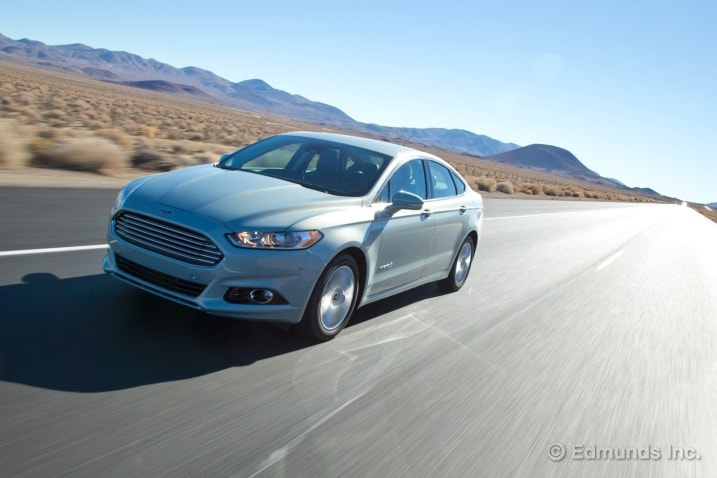
The Pretty 1: 2013 Ford Fusion Hybrid SE
Whereas the original Fusion Hybrid was a wallflower in terms of styling and sales performance, the new version is a knock-out. It looks fantastic and car shoppers have taken notice, with sales nearing (or even surpassing) the Camry Hybrid every month in 2013.
The Fusion's hybrid system operates in much the same way as the Camry's by combining a gas engine with a single electric motor. In the Fusion, the gas engine is a 2.0-liter 4-cylinder while the electric motor is powered by a space-efficient lithium-ion battery pack.
A base 2014 Ford Fusion Hybrid starts at $26,995 and includes roughly the same equipment as the most basic Camry Hybrid. The SE trim and a slew of packages are available for maximum flexibility while the other cars here are largely pre-packaged when it comes to options. Our loaded SE offered everything our Camry did in addition to driver memory settings, adaptive cruise control, an automated parking system and a lane-departure warning system. There is a higher Titanium trim available, but it's really just a loaded SE with slight visual differences and a Sony stereo.
The EPA estimates the Fusion Hybrid should return a very easy-to-remember 47 mpg combined (47 city/47 highway) which equates to burning 2.1 gallons per 100 miles.
For 2014, the Fusion is mechanically unchanged, but package content is altered and a few new features are available like ventilated front seats.

The New Kid in Town: 2014 Honda Accord Hybrid Touring
The 2014 Honda Accord Hybrid recently beat the 2013 Volkswagen Passat TDI in another comparison test of fuel-efficient family sedans. As we wrote then, "if fuel economy is the main priority of your next vehicle it's hard to do better?[it] is as impressive as a fuel-saving sedan as it is as a family sedan." Let's see how it does head-to-head with its hybrid competitors.
The Accord Hybrid deviates from the hybrid setups used in the Camry and Fusion. In the Accord there are 2 electric motors. 1 acts as a generator for the battery and various accessories, while the other powers the wheels in most driving situations. The 2.0-liter 4-cylinder gas engine is mostly on hand to replenish the lithium-ion battery pack, but can directly drive the wheels when necessary — say, during a full-throttle launch or at freeway speeds when good-old gasoline power is more efficient. Yes, it's complicated.
Less so is the way Honda packages together content for the Accord Hybrid. For $29,945, the base Hybrid trim gets you roughly the same equipment as the Camry XLE, albeit with a standard rearview camera and the Accord's LaneWatch blind-spot camera. The EX-L adds on a sunroof, leather, heated seats, satellite radio, a touchscreen display and forward-collision and lane-departure warning systems. Our range-topping $35,695 Touring model added LED headlights, adaptive cruise control and navigation (the only way to get this popular option).
The EPA estimates the Accord Hybrid should return 47 mpg combined (50 city/45 highway) or the equivalent of burning 2.1 gallons per 100 miles.

The Welterweight: 2014 Volkswagen Jetta Hybrid SEL Premium
"But wait!" you're no doubt saying. "The Volkswagen Jetta is a compact car, the others are midsize! They don't compete at all."
A valid point, perhaps, given the non-hybrid's rock-bottom base price and significantly smaller exterior dimensions. However, the Jetta is not as small on the inside as the outside suggests, with a comparatively sized trunk and backseat legroom that trails the others by mere tenths of an inch. The other metric is price, as a similarly equipped Jetta Hybrid is only about $2,000 less than the others.
The Jetta Hybrid also differs from the others in its hybrid technology. It, too, has a lithium-ion battery in the trunk, but features a 7-speed, dual-clutch automated manual transmission with an electric motor sandwiched in between it and a turbocharged 1.4-liter 4-cylinder. It's wholly different in design, but similar in that it can operate using either of its power sources or a combination of them both.
The cheapest, $26,015 base 2014 VW Jetta Hybrid is by special order only, so instead consider the $28,080 SE to be the point of entry. The Jetta SE is mostly on par with the base Fusion and Camry, but gets 6-way power seats (the others are 8-way), satellite radio and leatherette upholstery. Our SEL Premium stickered at $32,265, which included a Fender audio system, rearview camera and bi-xenon headlights. Advanced safety features like lane departure warning and radar cruise control are not available on the Jetta.
The EPA estimates for the Jetta are 45 mpg combined (42 city/48 highway) or 2.2 gallons per 100 miles for the Jetta Hybrid.
PHP Code:
Ford Fusion Hybrid Honda Accord Hybrid Toyota Camry Hybrid Volkswagen Jetta Hybrid
Price as Tested: $35,010 $35,695 $35,170 $32,265
EPA Fuel Economy (Combined/City/Highway): 47/47/47 47/50/45 40/40/38 45/42/48
Suburban Driving Test (MPG): 52.9 55.4 47.3 47.3
Suburban Driving Test (Gallons p/100 miles): 1.89 1.81 2.11 2.11
Rural Highway Test (MPG): 41.2 40.6 36.8 39.9
Rural Highway Test (Gallons p/100 miles): 2.43 2.46 2.71 2.5
Interstate Test (MPG): 44.0 46.4 42.2 47.7
Interstate Test (Gallons /100 miles): 2.27 2.16 2.37 2.1
Overall Test (MPG): 43.4 43.9 39.6 43.0
Overall Test (G p/100 miles): 2.3 2.18 2.55 2.32
Overall Test (Cost): $58.20 $57.35 $63.65 $62.32

4th Place: 2014 Toyota Camry Hybrid
Even if we ignored fuel economy, the Toyota Camry Hybrid would easily fall below the Fusion and Accord when rating family sedans. Though nearly as quick (0-60 mph in 7.6 seconds) as the Accord, the Camry Hybrid is the least responsive and least enjoyable to drive. The steering is oddly heavy and exhibits an annoying reluctance to return to center. The regenerative brakes also make all sorts of odd noises.
The backseat offers space on par with the Ford and Honda, but the front seat doesn't adjust low enough for taller drivers. The cabin also suffers from cheaper-looking plastics, while the trunk is less useful than the Fusion's.
When fuel economy is taken into consideration, however, the Camry Hybrid manages to fall even further behind. It was the least efficient car in every driving situation and the most expensive to fill up, even though the Jetta requires premium fuel. The fact the Camry was the only hybrid here to meet its EPA combined estimate of 40 mpg is at least a moral victory.
If you were to drive 12,000 miles per year and matched our fuel economy, the Camry would cost you an extra $103 per year to fill up than the Accord Hybrid. That's hardly breaking the bank, but why pay extra at the pump when there are 2 superior family sedans with similar prices and more available equipment that cost roughly the same?
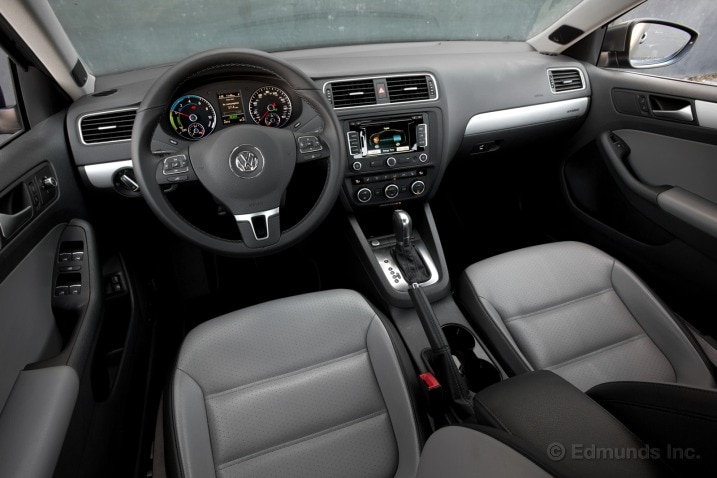
3rd Place: 2014 Volkswagen Jetta Hybrid
The Jetta Hybrid's turbocharged engine is ultimately its best asset and biggest detriment. Electric motors inherently provide a wealth of low-end power that push you into the back of your seat, and since turbocharged engines do as well, the Jetta constantly provides a neat 1-2 punch of torque. This not only makes it feel quick around town and confident during freeway passing, but the engine often sounds and feels less strained than the others. Its torque also helped it achieve the best fuel economy (47.7 mpg) on a hilly section of Interstate 15 between Las Vegas, Nevada, and San Bernardino, California.
Unfortunately, its turbocharged engine comes with the penalty of requiring 91 octane gas. Though the Jetta burned a mere 0.02 gallon more fuel than the Fusion Hybrid over the course of the test, it cost $4.12 more to fill up. Again, not the biggest of margins, but the Jetta lands in 3rd for other reasons.
True, its backseat and trunk give up little in terms of space, and it is $2,000 less than the others when similarly equipped. However, it feels like it should be cheaper still. The Jetta is significantly less substantial and refined, with an interior that, while well equipped, looks and feels Spartan. VW replaces the standard Jetta's hard, overly reflective plastic dash top with a soft-touch unit in the hybrid, but other materials pale in comparison to those in the Ford and Honda. The tiny infotainment touchscreen and its integrated rearview camera also drew complaints.
On the upside, the Jetta feels less hybridlike to drive and even sporty at times thanks to its peppy drivetrain, responsive brake feel and best-in-test stopping distance (117 feet from 60 mph). It also has smaller exterior dimensions and a quick-shifting 7-speed automated manual transmission (though the latter does cause the car to annoyingly roll back on hills). In this way, the Jetta at least offers unique characteristics the Camry does not.

2nd Place: 2014 Honda Accord Hybrid
It was clear from early on that this test was going to come down to the Accord versus the Fusion. The regular, non-hybrid versions are 2 of our top recommended family sedans and the hybrid models boasted the highest EPA estimates. Our 1st test, the suburban driving route, widened the gap with the Camry and Jetta even further.
When we filled up the Accord after 102 miles of mundane driving around Orange County, California, our calculations showed a wildly impressive 55.4 mpg. That was by far the best of the bunch, and it would come in 2nd on both highway segments. Overall, the Accord Hybrid was the cheapest to fill up, burning 2.18 gallons per 100 miles and costing $57.35. Yet, since most hybrids spend their lives commuting around suburbia, you may notice even greater long-term cost savings over the Camry and Jetta.
The Accord Hybrid boasts more than fuel economy, however. Its steering is direct and communicative, just like a regular Accord, instilling confidence whether we were driving amongst strip malls in Orange County or through volcanic peaks near Death Valley. The ride is also commendable, offering a substantially better blend of comfort and control than the Camry.
2 editors preferred the seats in the Accord to the Fusion's, with the backseat in the Accord feeling the most spacious. We also ranked its unique electronics interface the best of the bunch, though its combination of touchscreen, physical buttons and a multi-purpose knob still has some ergonomic foibles. We should also point out the Touring model's incredibly bright LED headlights, which trailed only the Luxor pyramid as brightest lights in Vegas.
Those attributes are very much intrinsic to every Accord, though. There are reasons the Accord Hybrid falls just a bit short. The main 1 is the engine, which loudly drones as it fights to replenish the battery under hard acceleration or when chugging uphill. Around town, the engine noise and your speed disconcertingly don't rise in step as you'd expect, pairing with a numb throttle pedal that offers unrelated engine vibration rather than feedback.
Furthermore, the trunk is also the least versatile and getting navigation requires the selection of the more expensive Touring trim. We still think the Accord Hybrid is as impressive as a fuel-saving sedan as it is as a family sedan, but it's outdone by the Fusion.

1st Place: 2013 Ford Fusion Hybrid
As each editor climbed out of the Honda and into the Ford, it was a common refrain that the Fusion is much quieter, more comfortable and even more responsive from behind the wheel. Importantly, it draws less attention to the fact that it's a hybrid, doing without the Accord's excessive engine droning and the Camry's abundance of electric whirring noises. The fact that the Fusion is by far the best-looking and most involving to drive is icing on the cake.
Like the Accord, the Fusion topped the mighty half-century mark in the suburban driving segment at 52.9 mpg. It was also the most efficient on the rural highway route, returning 41.2 mpg, and a very respectable 3rd on the high-speed interstate leg at 44 mpg.
Now, the Accord was indeed cheaper to fill up overall, but the difference was a minuscule 0.5 mpg or 0.12 gallon per 100 miles of driving. That's a difference of 85 cents for the test or about $14 over the course of a typical year. As all things were essentially equal on that front, other attributes became the determining factor.
Among them was the Fusion's useful trunk layout. Though its numerical capacity in cubic-feet is actually less than the Accord and Camry (12.0 versus 12.3 and 13.0, respectively), there is more usable space. The battery chews up the lower quarter of the trunk's forward half, creating a shelf that a suitcase or other items can still sit atop. More importantly, though, the design allows for the 60/40-split rear seat to fold down.
The Jetta's does a similar trick but its shelf is bigger and the pass-through smaller; the 2nd-best Camry provides the equivalent of a mailbox slot; the Accord an impenetrable wall. In this way, like the driving experience, the hybrid Fusion seems like less of a trade-off.
The cruise control was another best-in-test, fastidiously keeping speed both up and down hill. Less impressive is the Fusion's MyFord Touch electronics interface, but we've grown accustomed to it over time and preferred it to the Camry and Jetta's interfaces. In other words, we could live with it.
Which is a pretty good way to sum up the Ford Fusion Hybrid: for those who are new to hybrids, it'll be easy to live with. It feels the most like a normal car, while delivering the fuel economy you'd expect from a hybrid.
More to MPG Than Meets the Eye?or Wallet
Beyond our rankings, this test revealed other telling conclusions. 1st, only the Camry managed to meet its EPA fuel economy overall, while only the Jetta Hybrid managed to meet its EPA highway number.
Should hybrid owners be outraged or dismayed by this discrepancy? Not at all, because as this test's data shows and as we wrote in greater detail before, the differences in mpg of ultra-efficient cars like hybrids translate into minuscule monetary differences.
Therefore, it's important for car shoppers to note the "gallons per 100 miles" figure now found on every car's window sticker, and keep in mind that there's a lot more to consider when buying a hybrid family sedan than simply a number followed by the letters M-P-G.
#3748
I drive a Subata.
iTrader: (1)
Honda Accord is like the only thing I like from Honda/Acura line up today. 

#3749
Azine Jabroni
#3751
Azine Jabroni
#3752
The sizzle in the Steak
^^ no
The following 2 users liked this post by Moog-Type-S:
MeehowsBRZ (01-08-2014),
phile (01-09-2014)
#3753
I agree the Fusion looks hot on the outside, but out of all those sedans, the Accord's interior is the most inviting and spacious. The Fusion feels a little cramped compared to the Accord. That Camry's interior, even with the stitched dash, looks horrible.
#3754
Safety Car
I’m used to driving forced induction cars, from massive turbodiesel pickups to tiny Japanese imports with no more displacement than a soda bottle. I’ve always had an affinity for turbochargers, the so-called replacement for displacement, though I think I’ve found a replacement for turbos in the 2014 Honda Accord Hybrid. With its 2.0 liter Earth Dreams engine, the Accord Hybrid manages to blend comfort, fuel economy, and performance in a sedan that more than of my Millennial friends mistook for a BMW.
Of course my father recognized the Accord for an Accord the moment he saw it, but to me the Honda was handsome from pretty much any angle. It looked good without being flashy, and while the roads will soon be overrun with similar-looking models in just a few months, it’s hard to find flaw with its design. While other automakers are chasing the sculpted fluid look (think Hyundai and Ford), Honda’s Accord has grown into a burly big sedan with some serious chest hair. It may not sign any modeling contracts, but it definitely gets some 2nd looks.
The interior is comfortable, predictable, and plain, none of which are necessarily a bad thing. After being overloaded by Kia’s 42-button center console, having fewer systems to operate and worry about was a nice change of pace. On the same token, the number of information screens in the Honda Accord can get a little bit overwhelming, while at the same time being underwhelming; how many people really need to see whether the power is going into, or out of the battery at any given time? It just seems a bit superfluous.

Not all of the info screens were useless though, as I enjoyed watching my instant fuel economy rise and fall, and the coaching bars in the instrument cluster helped me maximize fuel economy when the mood struck. These coaching bars would rise and fall depending on how much power you were using or regenerating, but they never felt intrusive or judgmental, going from an environmentally-friendly green to a non-threatening blue when you step on the accelerator.
So let’s skip right on ahead to the good stuff; how does the Honda Accord Hybrid drive? In a word, beautifully. You’d never know this was a hybrid by the way it drives, feeling more like a gutsy V6 than a 2.0 liter 4-banger. Stomp the gas, and the Accord surges forward with the same gusto and torque as any other sedan in this segment, and while the official rating pegs the 0 to 60 MPH in the 7.1 second range, the Honda Accord Hybrid feels a lot faster. That’s thanks to a flat torque curve and a gearless E-CVT transmission the delivers power smoothly and with confidence, resulting in uninterrupted acceleration throughout the power band.
It’s an absolute pleasure to drive, and I never found myself wanting for more passing power at any speed. My only qualm is that at times, the hybrid system seemed to suffer from a sort of “turbo lag”, with a noticeable delay between pressing the pedal and actual movement forward. It was never so much a problem or even annoyance as it was something I quickly got used to, and unlike my experience driving other hybrids, I never had to back off from a passing maneuver because I ran out of acceleration.
This is, in short, a no-compromises hybrid, and 1 that starts just north of $30,000. It’s the anti-Prius, and once you start checking off the options list, it becomes a damn comfortable car too. Add in a massive sunroof, LED headlights, and a well-appointed leather interior, and the Accord Hybrid becomes a pseudo luxury car, loaded with the kind of technology and creature comforts (oh seat warmers, how I love thee) on par with many entry-level luxury options. Among my favorite features in my fully-loaded model was the adaptive cruise control and passenger-mounted turning camera, which broadcast my blindspot to the backup camera/touchscreen display every time I put on my left turn signal.

Sure, it’s still a Honda Accord, but at least 2 of my friends mistook it for a BMW, if you can believe it. Personally, I don’t see it in the least, but it happened more than once in the span of a week. That’s got to be worth something, though I haven’t even gotten to the best part yet.
Even with a heavy foot and high speeds, the Honda Accord Hybrid delivered fuel economy that makes puts my Chevy Sonic with its 1.4 liter turbo to shame. I never saw less than 38 MPG on the highway, and cruising at 70 MPH saw my MPG match or exceed the EPA ratings, which stands at 50 MPG city and 45 MPG highway for a combined 47 MPG. Thanks to the innovative hybrid system, I was able drive nearly 2 miles from my house to the grocery store on battery power alone. While it helps that most of the trip is downhill, in my old Jeep Wrangler a similar round trip consumed nearly a quarter tank of gas. Not an exaggeration.
Even though my tester came in at over $36,000, you can have a no-frills model sans navigation and leather seats, but equipped with a backup camera, for $30,000 if you include the destination fee. That’s the best bargain in the hybrid car market if you ask me, delivering an engaging driving experience and the kind of fuel economy that once required driving a car akin to an oversized go-kart (and with a much worse power-to-weight ratio).
For the average driver, the Honda Accord Hybrid can save as much as $700 a year in fuel costs, though those who do mostly city driving will see even more savings. I found myself hard pressed to come up with places to go in order to use up the fuel in my loaner during the week I had the car, a fantastic problem to have.
The following 2 users liked this post by TSX69:
Legend2TL (01-11-2014),
MuGen7Modulo (01-10-2014)
#3756
The sizzle in the Steak
Government investigates airbag injuries from Honda Accord
The National Highway Traffic Safety Administration has opened an investigation into potential airbag problems with Honda's 2008 Accord. The agency has received 28 complaints alleging inadvertent deployment of the side air bags.
"The complaints indicate the driver-side or passenger-side side curtain air bag and the side torso/seat-mounted air bag deployed when the driver or passenger door was shut," the investigation summary notes.
One of the complaints alleges that a Honda dealer told the owner that a passenger had shut the door too hard, and many of the complaints voice frustration that the damage wasn't covered by insurance because it was not caused by an actual accident. Alleged costs for repairs ranged from $1500 to $6000.
Two children were allegedly injured by the airbags, one with an arm abrasion and another with a concussion and laceration, though none of the complaints have reported deaths or life-threatening injuries.
The NHTSA has yet to announce a time frame for its investigation, which could lead to the recall of 363,000 vehicles.
"The complaints indicate the driver-side or passenger-side side curtain air bag and the side torso/seat-mounted air bag deployed when the driver or passenger door was shut," the investigation summary notes.
One of the complaints alleges that a Honda dealer told the owner that a passenger had shut the door too hard, and many of the complaints voice frustration that the damage wasn't covered by insurance because it was not caused by an actual accident. Alleged costs for repairs ranged from $1500 to $6000.
Two children were allegedly injured by the airbags, one with an arm abrasion and another with a concussion and laceration, though none of the complaints have reported deaths or life-threatening injuries.
The NHTSA has yet to announce a time frame for its investigation, which could lead to the recall of 363,000 vehicles.
#3757
Senior Moderator
The second I saw "Millennial" in that article, the writer lost all credibility.
#3758
Safety Car
America's midsize sedan segment is 1 of the most crowded and fiercely competitive in the business. The Toyota Camry has long been our nation's best seller, while the Honda Accord has dutifully come in 2nd place, like some sort of codependent Cal Naughton Jr. riding Ricky Bobby's back bumper.
There was that 1 year, 2001, when the Accord briefly broke the Camry's streak, marring what would today have been a 17-year-long run of best-selling car titles. The Accord pulled the opposite move in 2011, letting sales slip far enough to let not only the Toyota by, but the Nissan Altima and Ford Fusion, as well. Aside from those anomalies, the Camry and Accord have been 1st and 2nd in this segment since before many of you readers could even drive.
It's 2014, and these frenemies have never before faced a threat to their world order as strong as today's class of family sedans. The aforementioned Altima and Fusion are perhaps the most capable challengers, but the Chevrolet Malibu, Hyundai Sonata, Kia Optima, Volkswagen Passat and Mazda6 are all capable of convincing new buyers to walk their way.
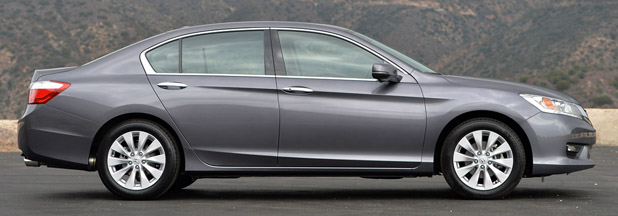
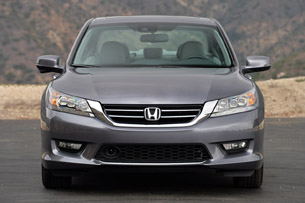
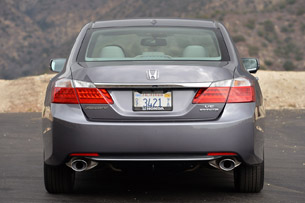
We at Autoblog predict the lineup of best-selling midsize sedans is about to be shuffled. We gave the current-generation Camry a pretty harsh review, and were it not for Toyota's fiercely loyal customer base and increased incentive and ad spending, the king might have already stepped aside. The question for Honda is whether or not the Accord's latest redesign is good enough to keep it ahead of this charging pack of competitors, or whether it follows the leader right off the podium steps.
Honda played it decidedly safe with the Accord's styling when the sedan was redesigned last year. Few would argue that the new shape isn't an upgrade over the prior model, though it has been hit with criticism for being too derivative, particularly in the rear where it could be mistaken for a 2008-2014 Hyundai Genesis (it's not the worst thing in the world to draw likenesses to class-above sedans).
The dimensions of the new design are perhaps more interesting than the way it looks. The Accord is now some 3.6 inches shorter in length, while also being shorter in overall height and a touch wider than the last-generation model. The vehicle's stance certainly reflects those changes, and the wider front fascia that flows into gently upswept headlights looks more aggressive to our eyes, while at the same time remaining recognizable as both a Honda and an Accord.
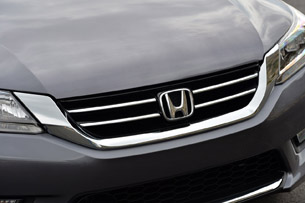
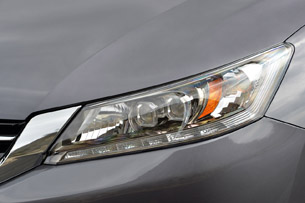
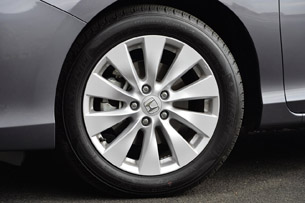
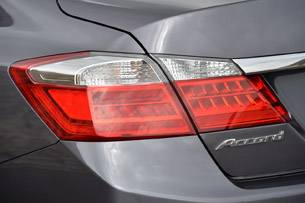
Those exterior dimensions, of course, also affect how much room there is inside, and on paper, at least, there's less: 103 cubic feet of passenger volume, down from the prior generation's massive 106. Fortunately, the exterior shrinkage hasn't made the Accord feel appreciably smaller on the inside, with plenty of space available in all directions and wide, comfortable seating for all. In fact, many key interior metrics have grown, like rear legroom and trunk space (up over a cubic foot to 15.8). Those 3 missing cubic feet of passenger volume appear to have been taken off the top, as front and rear headroom have both taken dips. Despite our tester's moonroof, however, there was still plenty of clearance, even for passengers with 6-foot, 2-inch frames.
The new dimensions have also dropped the Accord down a class in the Environmental Protection Agency's classification system; whereas the prior Accord (8th generation, for those counting) crossed the threshold of 120 cubic-feet of combined passenger volume and cargo space to become a fullsize car, the new Accord's 118.8 cubic-feet of combined interior space keeps it among the midsizers.
In top-trim Touring spec like our tester, the Accord's interior impresses with high-quality materials like nicely trimmed leather seats and dashboard plastics that generally look and feel better than is typical of this pricepoint. Almost everything about the interior, from its space and materials to the ergonomics of little things like the smartphone-sized cubby next to the power and USB ports, is well thought out and easy to use. Except the infotainment system. With our 1st Drive of the new Accord having been conducted in a Sport model lacking the upgraded infotainment system, this is our 1st chance to talk about Honda's dual-screen system in the Accord.
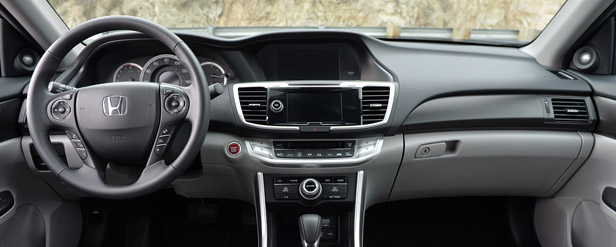
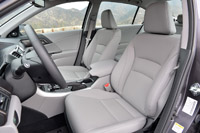
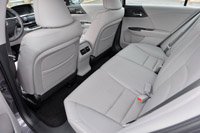
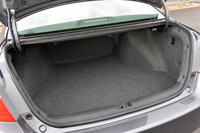
The 1st screen is a large 8-inch unit that's deeply embedded at the top of the center stack. This display is not touch sensitive, but rather controlled via rotary knob controller and set of buttons at the very bottom of the center stack. These controls, however, still require a reach, because they are not laid flat on the center console, so they don't fall readily to hand like many other high-end systems. Below this big screen is a smaller display dedicated to audio functions. This display is touch sensitive, and lets you perform simpler tasks like switching music sources and advancing tracks.
We have a few issues with this setup, the 1st being its redundancy and generally poor use of the audio-only screen. Most of the functions it performs can also be performed on the main screen using the knob controller, and the interface itself is more difficult to use than a simple set of physical buttons, because tasks often require the extra step of switching between screens. Our 2nd gripe concerns operating the system on the larger screen using the single rotary knob and buttons. In particular, the Menu button manages to confuse because it doesn't go to a top-level menu as expected. Rather, it takes you to a menu of options for whichever part of the system you happen to be at that moment, be it Navigation, Phone or Audio.
Lastly, the presentation of the system is decidedly a few years behind next-gen systems coming out from Honda's competitors. The graphics, fonts and colors layered atop a confusing hierarchy of menus and controls makes the whole system feel like Windows 95 when everyone else is rocking Windows 8. We've tested many other systems in this competitive set and have found simpler schemes that rely on a single, large display with either touchscreen or well-designed central controller – this system is too complicated for its own good.
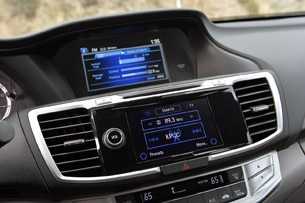
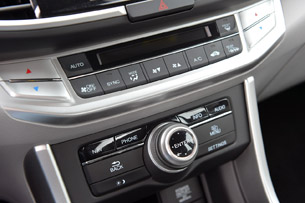
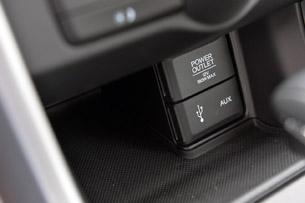
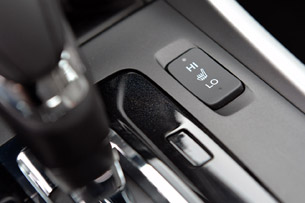
That doesn't mean Honda doesn't know how to do technology in these modern times, as our Accord also came equipped with the brand's new LaneWatch system. Any time the right turn signal is activated, a camera mounted underneath the passenger-side mirror is used to project a view of the car's blind spot, along with handy distance markers, on the main infotainment screen. At 1st we thought LaneWatch might be an overly complex solution to the simple problem of people not adjusting their mirrors properly, but in practical use, we found it not only helpful, but preferable and more trustworthy than the mirrors themselves.
While many midsize challengers have ditched offering a 6-cylinder engine altogether, the Accord continues to make the heavier, more powerful engine option available. In this case, it's Honda's well-proven 3.5-liter V6 that produces 278 horsepower at 6,200 rpm and 252 pound-feet of torque at 4,900 rpm. While 1 might think the Accord would suffer a big penalty at the pump for such a powerful mill, the opposite is actually true, thanks in large part the Honda's comparatively svelte curb weight and its Variable Cylinder Management system. While cylinder deactivation technology is nothing new, its application on a V6 is rare outside the engine bay of a half-ton pickup.
The ability to run on half its cylinders helps the Accord achieve excellent EPA-estimated fuel economy figures of 21 miles per gallon in the city, 34 on the highway and 26 combined. Our results were even better, with the trip computer reporting an average return of over 30 mpg after a week of mixed driving. The official numbers put this Accord ahead of all top-trim midsize sedans, including the Fusion, Sonata, Optima and Malibu, all of which offer powerful turbocharged and direct-injected 4-cylinder engines in their most expensive models. We've noticed that these high-tech forced-induction 4s tend to get strong window-sticker EPA numbers but fall flat out in the real world. This Honda doesn't make economy promises that it can't keep.
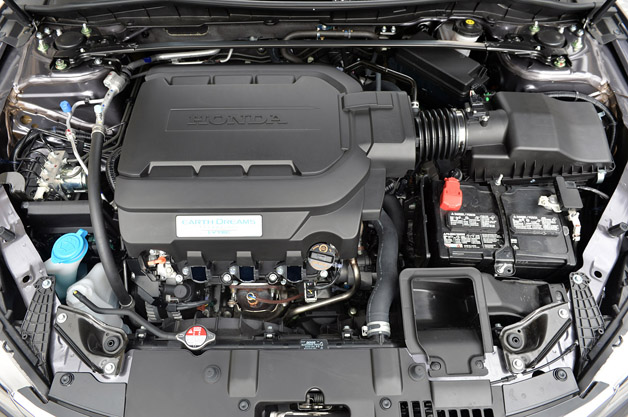
Of course, the Accord's engine management system will tell 3 cylinders to take a rest every chance it gets, even more so when the car's Econ button is pressed. While amazing fuel economy is the result, the byproduct is an occasionally rougher-running engine you can feel through the steering wheel and pedals. The vibrations while running on fewer cylinders might not bother some, but we found them very noticeable, and there's no setting to turn off the Variable Cylinder Management system entirely, so they're practically always present with the engine dropping and bringing cylinders back online constantly. Honda says that all Accords are also fitted with an Active Noise Cancellation system, but we found the overall levels of noise, vibration and harshness to be average at best – definitely not approaching industry leaders in that area from near-luxury brand Buick, which use a similar Bose-branded noise cancellation technology in its Regal, a slightly more expensive (and smaller) rival.
The Accord doesn't sell hundreds of thousands of units per year because it's such a smooth operator, though. We'd venture to say the car's reputation for offering the most engaging handling among midsize sedans is its chief selling point (along with a history of reliability and a strong dealer network that combines to inveigle legions of repeat customers). We're happy to report that the Accord is still at the front of the pack in terms of handling. Pairing a very rigid unibody platform with a MacPherson strut front suspension and multi-link rear suspension yields a highly diversified setup that's comfortable counteracting imperfect city streets but also stable and composed when the pace picks up and the turns become sharp. While the steering system has become all-electric in this latest generation, its accuracy and weight still feel sharp and natural, though there is a lack of feedback from the road through the wheel. Likewise, the brakes that measure 11.5 inches up front and 11.1 inches at the rear are go-about-your-business great, offering perfectly natural feel through the pedal.
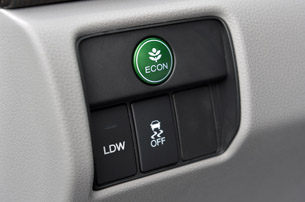
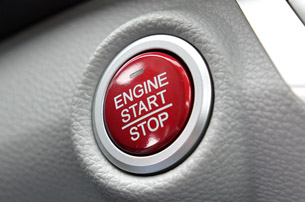
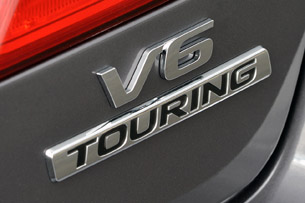
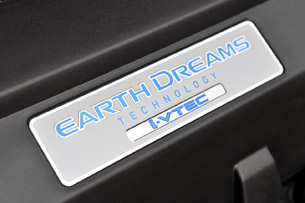
Having driven nearly all of this year's midsize contenders, we can say there's no other family sedan on the market with mechanicals that operate in such harmony. From the powertrain to the transmission to the suspension to the steering, all of the Accord's subsystems are on the same page with each other from the moment the start button is pressed. Most of its competitors nail 1 or 2 of these disciplines, but rarely do they come close to a complete package like the Accord (the Mazda6 is the exception, though which is better is close enough to be a matter of taste). What's more, there's even a 6-speed manual transmission still available on LX, EX and Sport models, though the EX-L V6 and our Touring tester are only available with this well-tuned 6-speed automatic.
Really, the only fault we could find out on the road with this Accord was not with its mechanicals, but with the Adaptive Cruise Control system that exhibited some worrisome behavior. We set the ACC during a long trip on the highway and discovered that when traveling through a left-hand bend with something like a big pickup or semi truck on our right, the radar-based system would register that vehicle as being in our path and the Forward Collision Alert system would sound its alarms and flash warnings in the instrument panel. At the same time, we suspect the Brake Assist system had also precharged the brakes, because when our foot instinctively went to tap them, we got more braking power than we expected. An unsettling experience each time, this happened more than once during our trip. We can't rule out that the bumper-mounted radar on our particular test vehicle may have been misaligned or otherwise defective, but we've experienced this fault on other automakers' vehicles with similar systems before as well, so we doubt it.
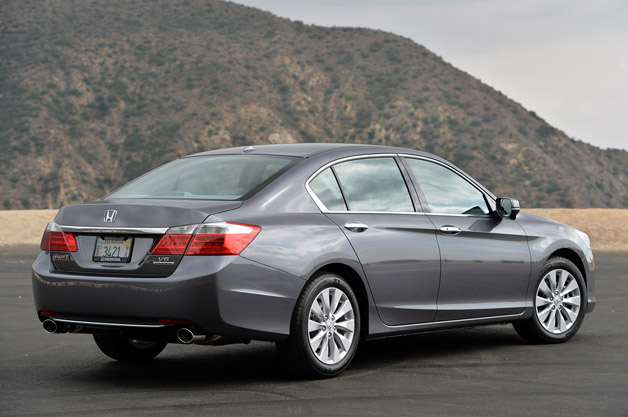
Lastly, the Accord Touring we tested features a base price of $33,480 with a destination and handling charge of $790. At 1st blush, that may seem more expensive than its pack of competitors, but note there's not an option available that isn't standard with this trim. For instance, while a Ford Fusion Titanium may start lower at $30,600, once navigation, adaptive cruise control, blind spot alert, lane departure warni
What we find with the 2014 Accord Touring is a lineup-leading model that bodes well for the future of Honda. Still among the very best-handling midsizers in this market, the Accord ups the ante with its improved design, more interior space where it counts and efficiency that belies the power of its remarkable V6. The issues we identified with the infotainment system may be a sticking point for some, especially those comparing the experience closely across the entire segment, but there are lesser trim levels available that go without navigation yet gain a much more straightforward interface. Indeed, it's not so egregious a failing that Accord sales have suffered because of it, and we don't see anything about this new generation that will threaten its place among the segment's top sellers.
At this point, the only thing preventing the Accord from being America's best-selling car are a bunch of stubborn Camry buyers.
The following 2 users liked this post by TSX69:
Legend2TL (03-05-2014),
MuGen7Modulo (03-05-2014)
The following 4 users liked this post by charliemike:
#3760
Moderator


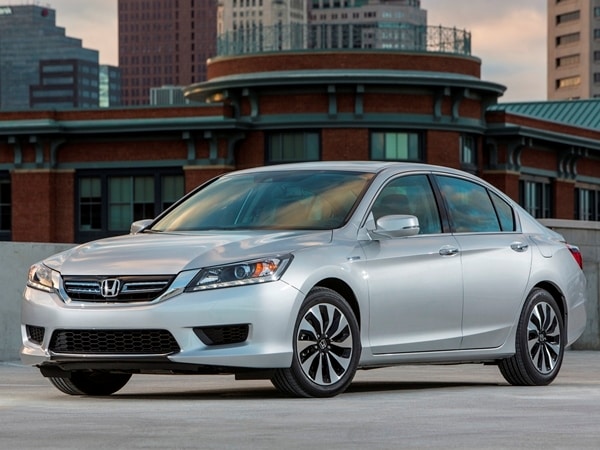





 Bit surprised.
Bit surprised.


